What is Facebook PPC? Let’s start off with a quick history lesson and learn some new acronyms. (We’ll keep it short, promise!)
So… What is this thing called PPC advertising?
The term PPC comes from the well-known online advertising platforms’ payment system pay-per-click (PPC). A user clicks on your ad, you pay to the ad platform. Easy!

With PPC ads, you pay per each click – Image source
As most ad platforms bill on the CPC (cost-per-click) basis, the term PPC has become synonymous with online advertising in general.
Is Facebook also a PPC platform?
The best-known PPC advertising platform is Google Ads while Facebook, in reality, offers more billing options than pay-per-click.
When setting up ads in the Facebook Ads Manager, you’re able to select whether you’d like to pay based on 1000 ad impressions or per link click (CPC).
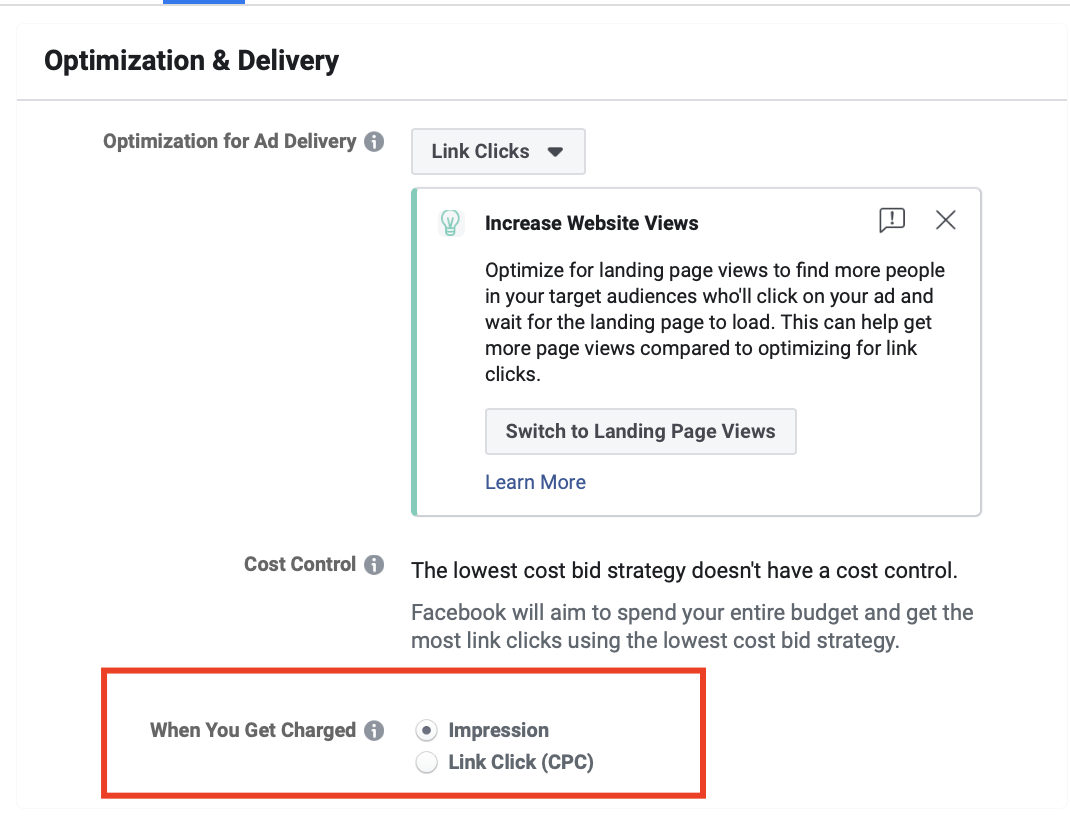
You can also pay per click on Facebook Ads Manager
So, to give you a definitive answer, you can run PPC ads on Facebook, especially if your goal is to bring traffic to your website.
Up next, we’ll share with you some smart n’ sneaky Facebook PPC strategies to bring more traffic to your website, close more sales, and keep your user base engaged. 🤜💥🤛
Here are quick navigation links to reach the part of this article that interests you the most:
Facebook PPC strategies for higher website traffic
Facebook PPC strategies for closing more sales
Facebook PPC strategies for engaging your users
15 Facebook PPC hacks for doubling your results at no extra cost
🚀 Facebook PPC strategies for higher website traffic
Who wouldn’t want to have more people visiting their website?
More visitors = more leads = more sales = profit. 💰
Well-designed and -written Facebook ads can be a great source for additional website traffic. It’s also an efficient channel for building brand awareness as Facebook’s algorithms are on top of the game when it comes to finding people interested in your brand and product.
What about Instagram PPC? Instagram is part of the Facebook ad network, so when setting up a Facebook ad campaign, we recommend that you always keep on the Instagram placements. The visual content-oriented social media platform is quickly catching up with Facebook in user engagement.
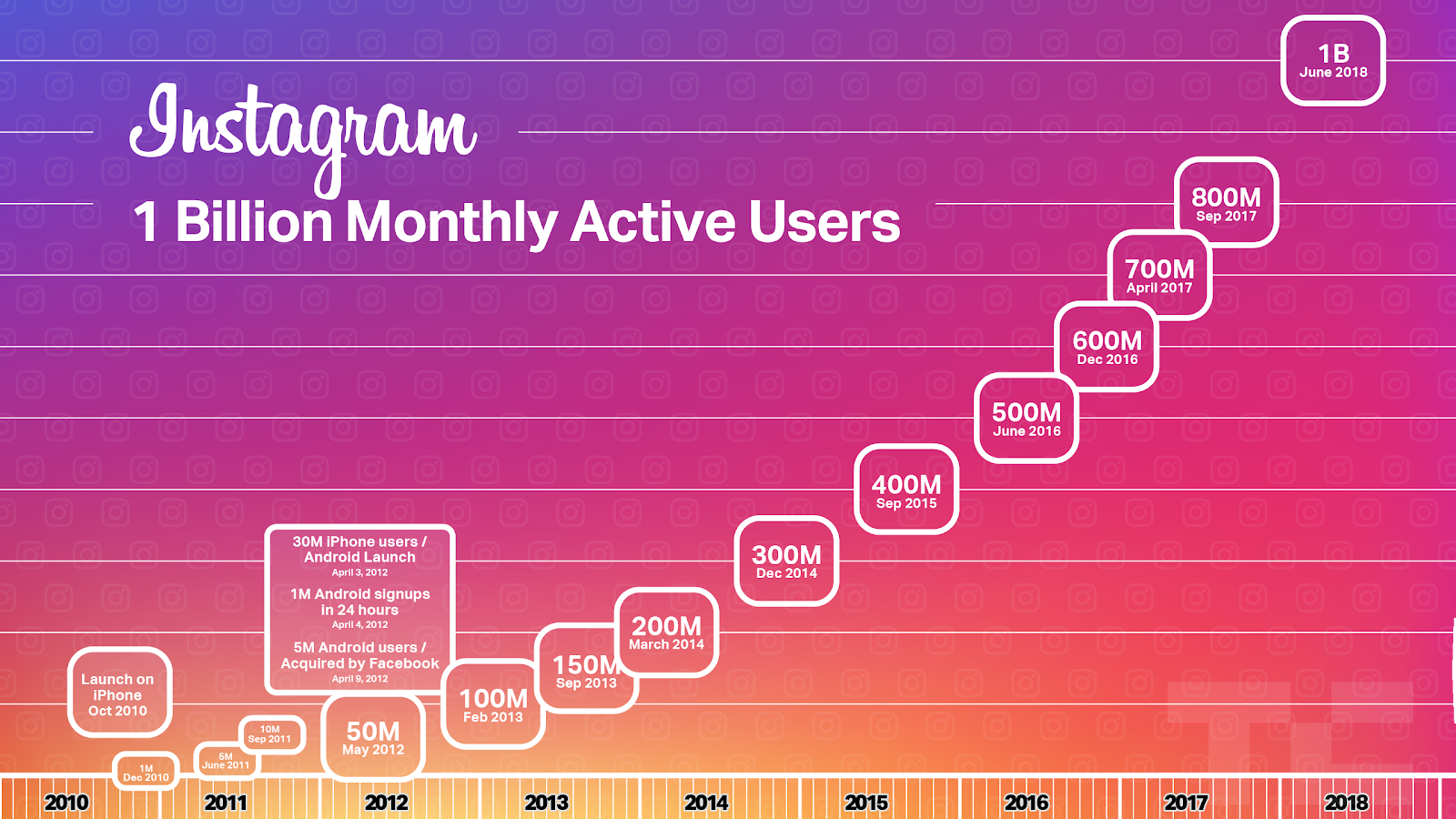
Advertise both on Facebook and Instagram – Image source
Alright, let’s take a look at how to set up highly efficient Facebook PPC campaigns to bring extra traffic to your website.
1. Set up a Facebook Traffic campaign that leads to your home page
The most common Facebook ad strategy for bringing additional traffic to your website is a simple Traffic campaign that leads people to your website once they click on your ad.
Usually, brands use the Traffic ads to bring a high volume of new users either to their home page or specific landing pages and later set up remarketing ads to convert the visitors into customers.
For example, Upwork’s Facebook ad introduces its service’s benefits and leads people to their website where they can explore further.

Upwork’s Facebook ad
As you click on the ad, you’re taken to Upwork’s home page.
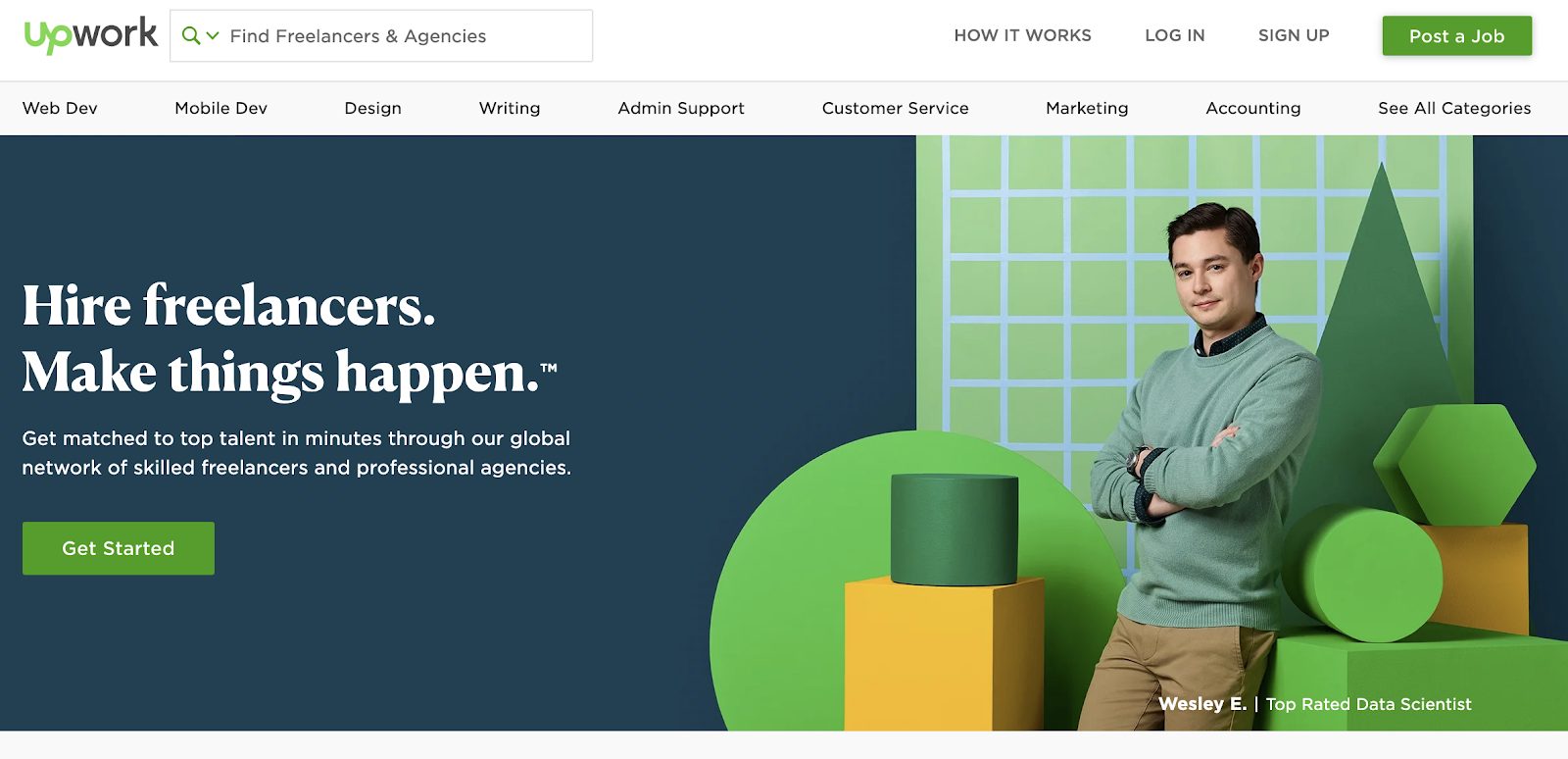
Upwork’s home page
If you’re intending to send people to your website’s home page, make sure that there’s a clear call to action on what they’re supposed to do next. In Upwork’s case, they’re leading people to fill in a sign-up form to start hiring freelancers.
In Linear Design, we recommend our clients to run Facebook Traffic campaigns if the goal is to create brand awareness. If you want to get people to buy a specific service or product, it’s more effective to direct your ad traffic to specific landing pages.
This leads us to the next Facebook PPC strategy…
2. Use Facebook ads to send people to specific landing pages
Imagine you’re selling project management software. There are several buyer personas and use cases that you can target.
For example, there are people looking to manage their personal schedule, teams of 10 people looking to streamline their work, and companies with 100+ employees in need of a task management tool.
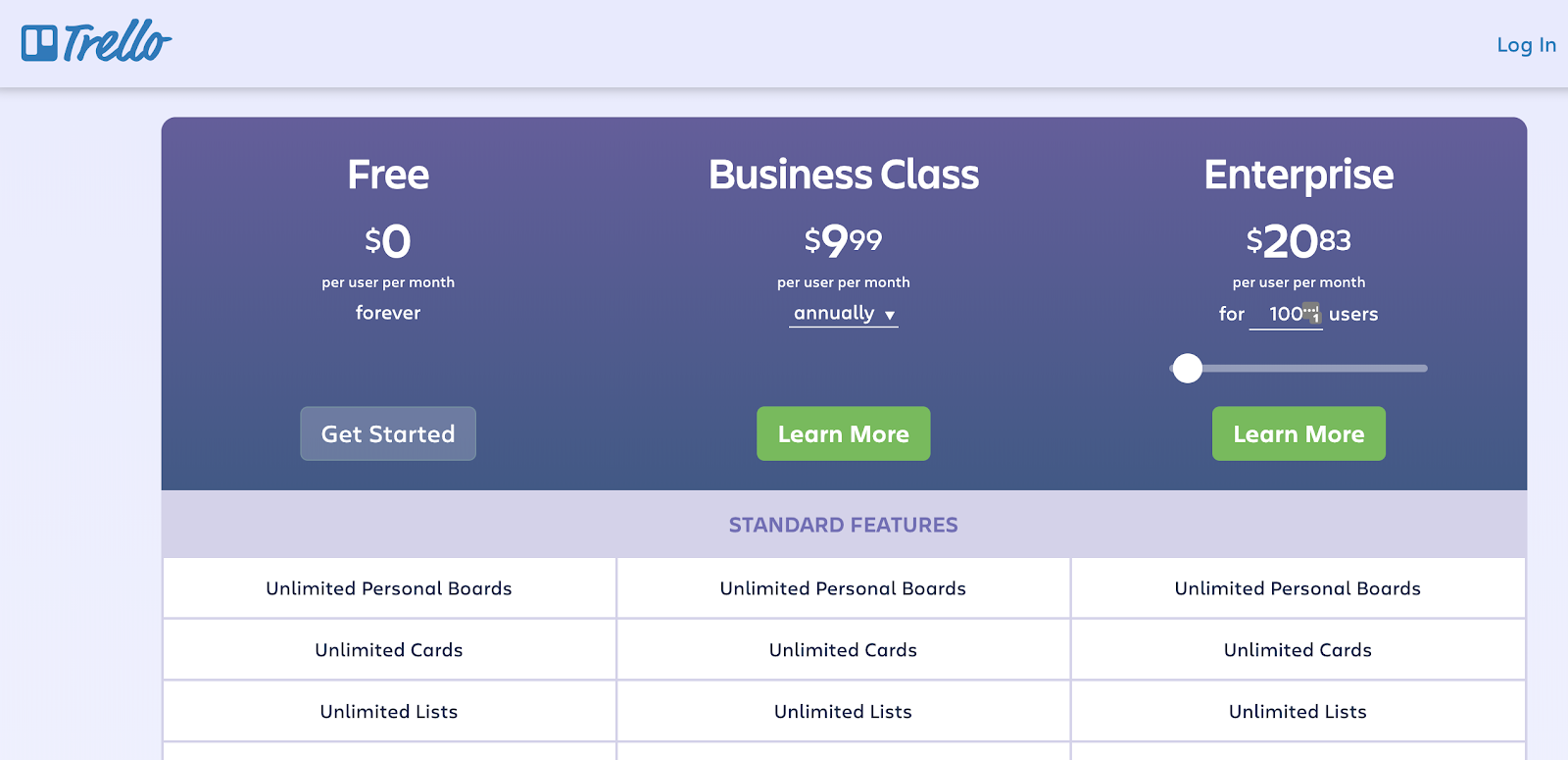
Trello offers a tool for various use cases
Instead of leading all people to your home page, create a Facebook Traffic campaign for every different use case.
In Trello’s case, this would mean setting up an ad campaign (with various creatives and copy) for at least three user segments:
- People interested in personal task management
- Small teams of 10-30 people looking for a simple project management tool
- Big companies with 100+ employees where multiple in-house teams need a tool for faster and transparent collaboration
There’s a list of benefits to directing ad traffic to specific landing pages:
- You can craft your ad message for specific audience segments
- Facebook’s algorithms will learn to target the right audience who’s interested in your specific product tiers
- You will have a clearer overview of which offer works best for the audience available on Facebook
For example, CoSchedule’s Facebook ad is specifically addressing social media marketers that need a tool for resharing posts. This doesn’t mean that CoSchedule wouldn’t have any other tools – they’re simply running various ads targeted at different audiences.
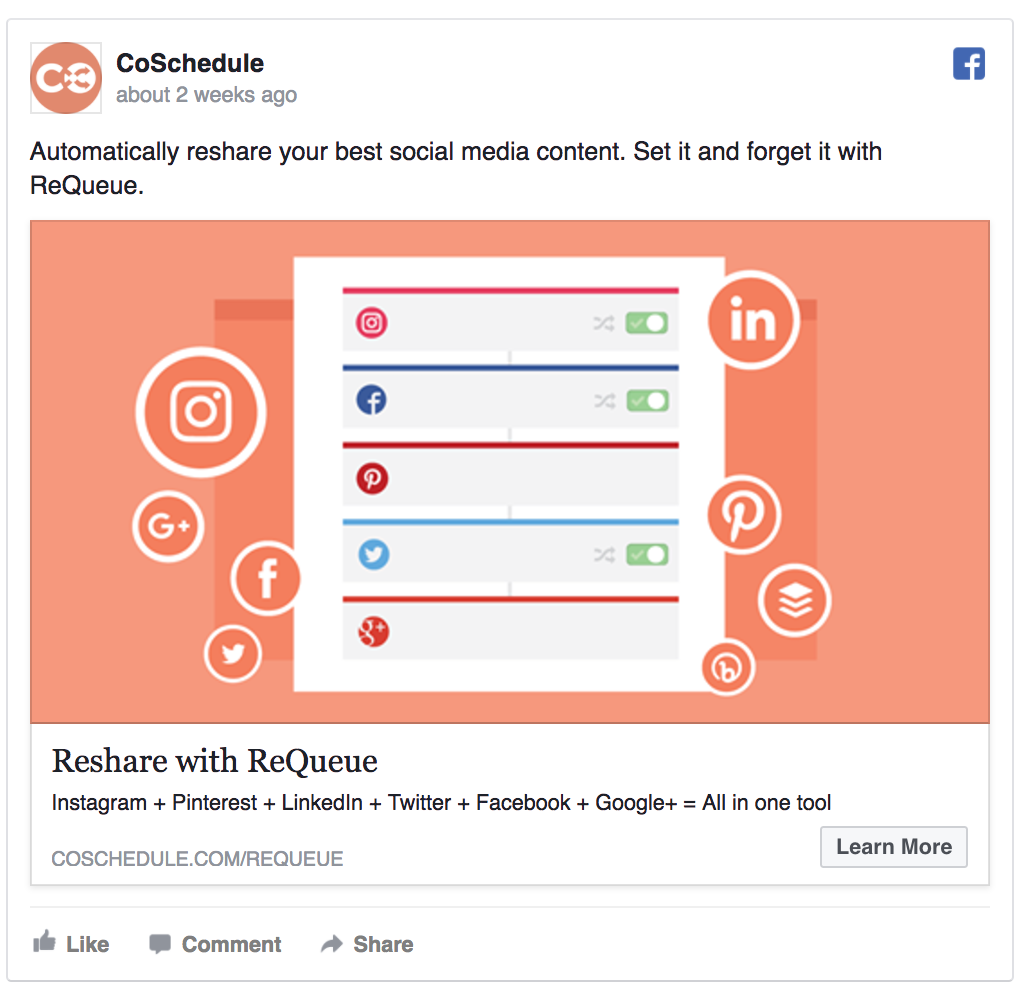
Coschedule Facebook Ad ☝
3. Send Facebook ad traffic to your blog
If you’re working on content marketing, you’re probably publishing blog posts to increase your organic website traffic while also educating your audience.
If you’ve ever written a blog article, you also know that it takes up to 10-20 hours to write an article, edit it, and publish it.
By the time you’ve managed to publish the article to your blog, you’re tired of working on it. In reality, that’s where the real work begins. Now, you will need to put all your energy into promoting the article and making sure a sizeable audience will see it.

After an article writing marathon – Image source
Look at it this way: You can publish a ton of blog articles, but only the ones that reach people will gain traction and bring business results.
You could more than double your blog results by simply spending a few extra hours on promoting it (it’s only 10% of the total time you spent on writing and publishing the article!)
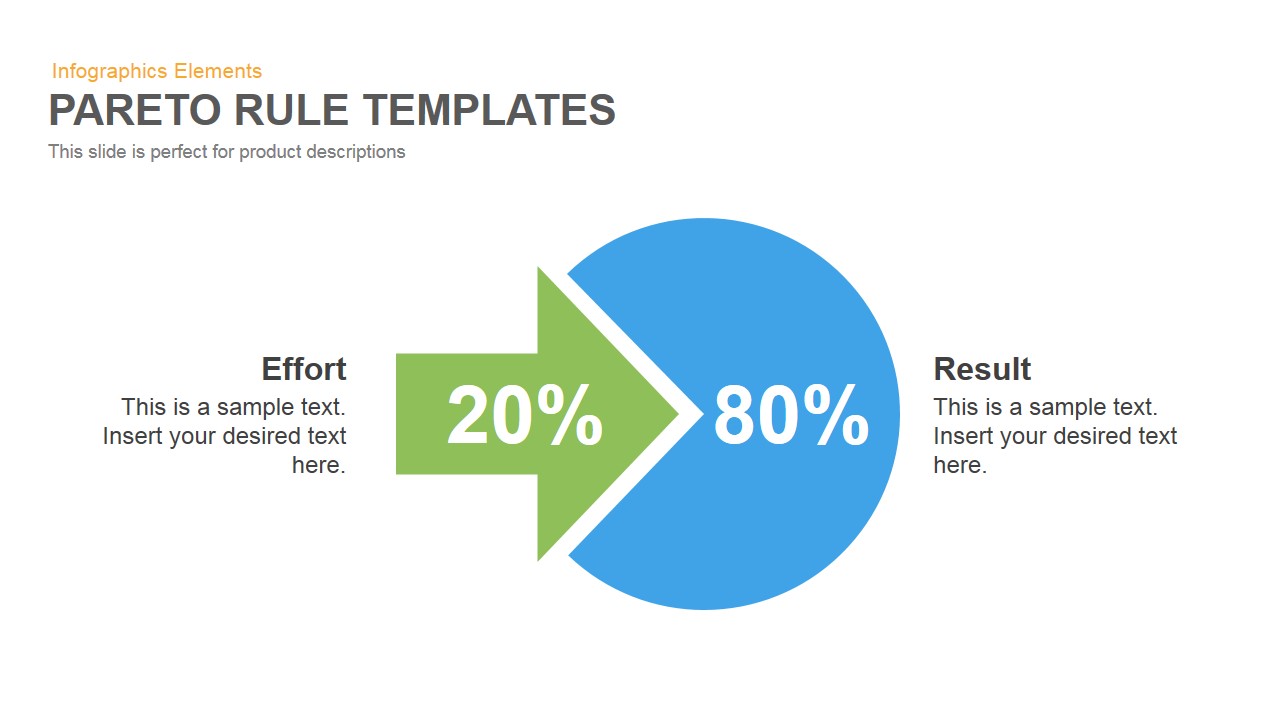
Pareto principle – Image source
The first step to promoting a blog article on Facebook is to share it on your brand’s Facebook page. Up next, you can set up a promotion to make it reach thousands of people.
Do not count on Facebook’s organic reach as according to the reports, your page posts only reach around 5% or less of the people liking your Facebook page.
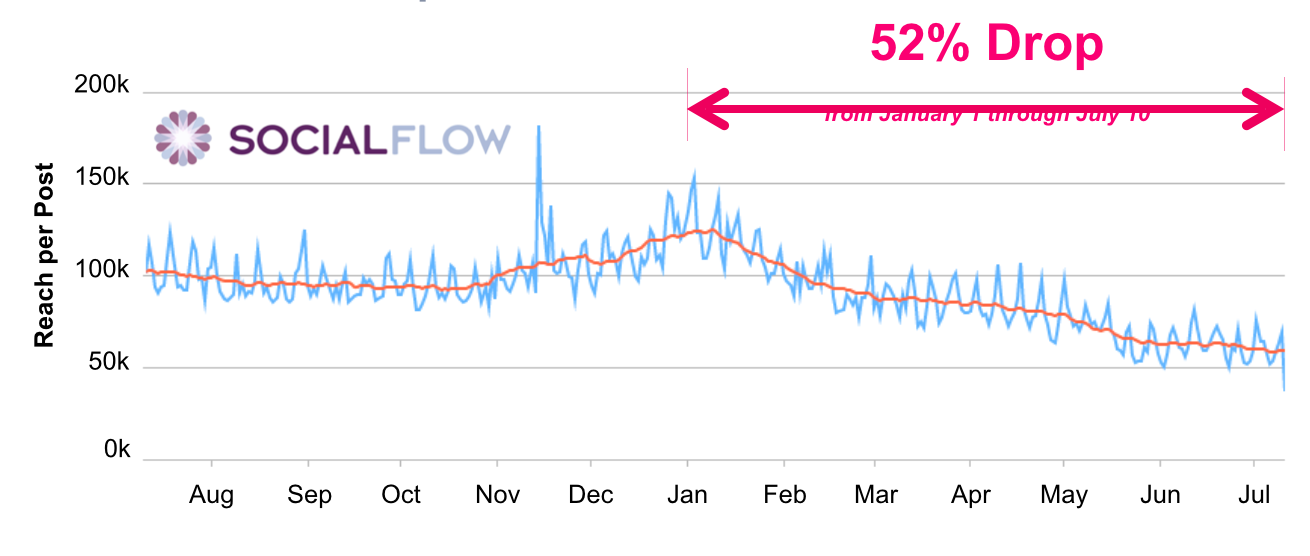
Facebook posts’ organic reach keeps dropping – Image source
Here are two pro tips for promoting your blog posts on Facebook:
- Before setting up a paid promotion, ask your friends and team members to like and share the post to create a higher organic reach and collect likes to your Facebook post
- Set up your Facebook page promotions via the Ads Manager instead of using the “Promote post” button under the post. You will get better results at lower costs.
Here are two good examples of Facebook posts engagingly promoting a blog article and a survey:
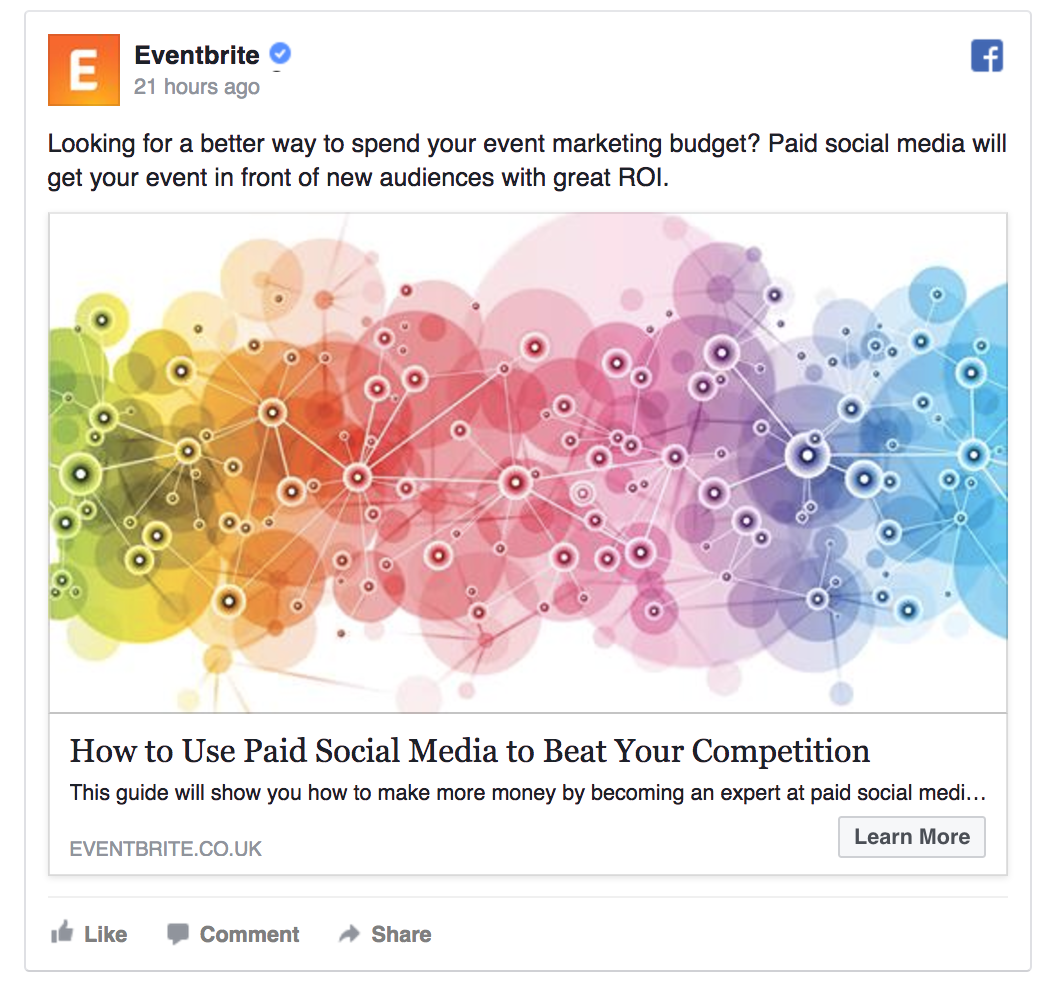
Eventbrite Facebook Ad ☝

Eventbrite and Ahrefs promote their blog content on Facebook
4. Set up Facebook Traffic campaigns like a pro
Not all Facebook Traffic campaigns are created equal. Your ads’ success depends on a variety of aspects, from creative to campaign setup to the target audience.
So how can you set up Facebook (and Instagram) PPC campaigns like a pro? We’ll share some tips!

How to reach people who will love your product? – Image source
1. Target a broad audience of 100k+ people
When setting up your Facebook ad sets, we recommend that you keep your target audience wide (at least 100 000 people) rather than narrowing it down based on interests.
Facebook’s algorithms learn which types of people click on your ads and will optimize the ad delivery based on their learnings. It makes more sense to let the algorithms evaluate your target audience based on thousands of data points instead of using manual targeting definitions that are much more limited.
2. Optimize your campaign on landing page views
When setting up the ad sets for your Facebook PPC campaign, you will have the option to optimize on link clicks and landing page views.
Here’s the difference:
Link clicks: This is the total number of link clicks to the destinations on or off Facebook (websites, Facebook lead forms, videos on YouTube, etc.). If you include Instagram as a placement, for “ads promoting Instagram profile views, link clicks include clicks on the ad header or comments that led to the advertiser’s profile.”
Landing page views: Explanation from Facebook: “Landing page views let you know how many times people loaded your website, after clicking your ad. You can compare landing page views to link clicks to understand how many people clicked on your ad but left before your website loaded. To report on landing page views, you must have created a Facebook pixel.”

Optimize your campaigns on landing page views
If you optimize your ad campaigns on landing page views, you can get higher-quality traffic to your website.
3. Use at least 3 ad creatives per ad set
Various people react to different visual queues.
One person might be drawn to yellow ad creatives while another is attracted by red colors in their Facebook news feed.
That’s why we recommend using a variety of different-colored ad creatives in each campaign.
For example, the project management tool Scoro uses a wide set of different ad creatives in their Facebook campaigns.
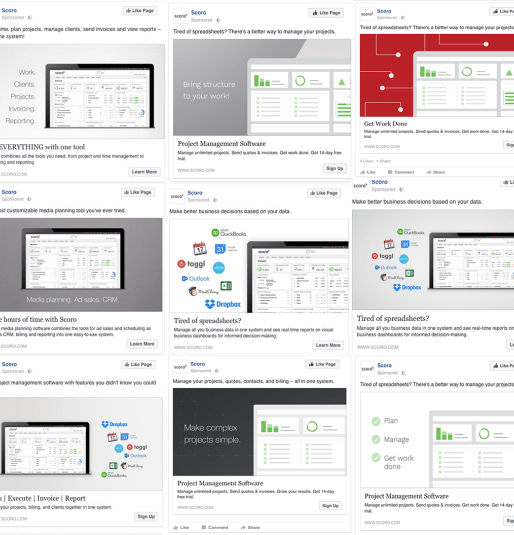
Scoro uses many various ad creatives
You can also add new ad visuals to existing campaigns from time to time to stir things up and see if a new creative will outperform the current ones.
5. Host Facebook giveaways to gain traction
If you’re not yet running giveaways on Facebook, you’re missing out on one of the best ways to get people to engage with your brand and reach a wide audience.
Free stuff giveaways are like honeypots that attract people to your brand and get them to share the news with their family and friends.

People love free giveaways – Image source
You can offer to give away almost anything, but generally, B2C brands have it easier as people usually want to win things that are useful in their daily lives: free shopping credit, gifts, etc.
For example, the clothing brand The Kooples is using a Facebook giveaway to grow the Instagram follower number.
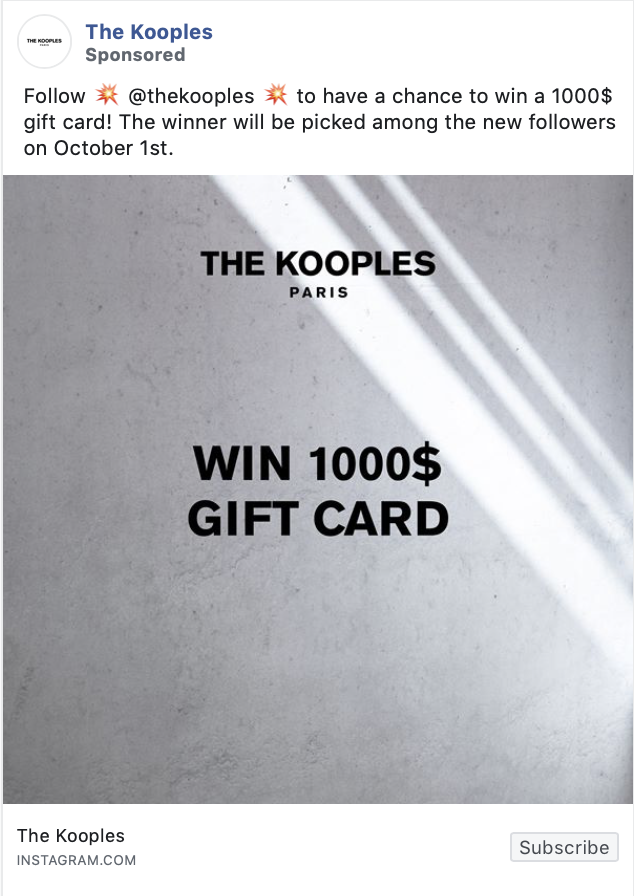
The Kooples gives away $1000 of shopping credit
How to run an efficient Facebook giveaway:
- Offer something that 90% of people would want to get.
- Ask people to tag their friends in the comments to increase virality.
- Promote your giveaway to give it an extra boost.
6. Target Lookalike audiences of past website visitors
Once you’ve run Facebook PPC campaigns to lead traffic to your website and have 5000 or more visits, you can take advantage of Facebook’s audience targeting solutions.
We recommend to set up a Facebook Lookalike audience of your past website visitors, so that you can reach more similar people interested in your product.
Here’s how Facebook Lookalike Audiences work:
When you create a Lookalike Audience, you choose a source audience (a Custom Audience created with your pixel data, your mobile app data or fans of your Page) and Facebook identifies the common qualities of the people in it. Then, the algorithms will find more people similar to your source audience.
We suggest to create Lookalike Audiences with the size is between 1,000 to 50,000 people.
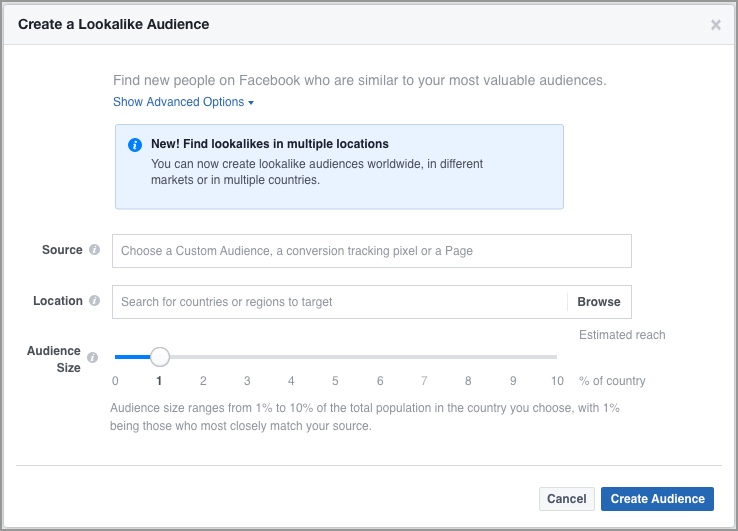
Lookalike Audiences are country-based – Image source
Facebook shares some additional suggestions:
- It can take 6 to 24 hours for your Lookalike Audience to be set up. After that, it’ll refresh every 3 -7 days if you’re still actively targeting ads to it
- You don’t need to wait for your Lookalike Audience to update to use it for ad targeting
- You can see when your Lookalike Audience was updated by visiting your Audience Manager page and looking at the date under the Availability column
So, to wrap this up:
- Create a Custom, Audience of all past website visitors in the past 30 days
- Set u a Lookalike Audience based on the Custom Audience you just created
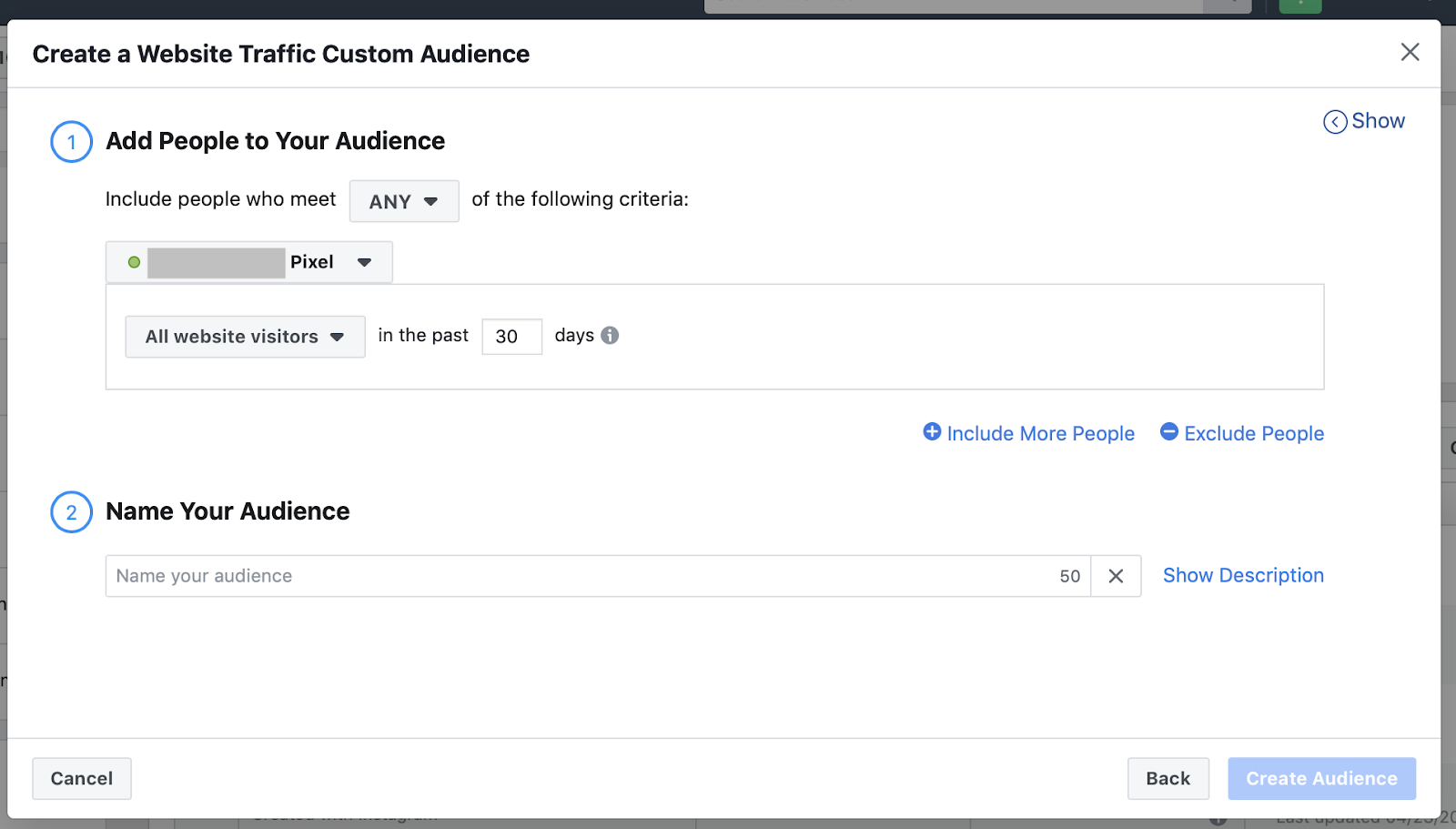
You will need the Facebook Pixel to track website visits!
7. Run a broad brand awareness Facebook campaign
In addition to Traffic campaigns, you can also run ads with Brand Awareness objective.
So what’s the difference between Traffic and Brand Awareness campaigns?
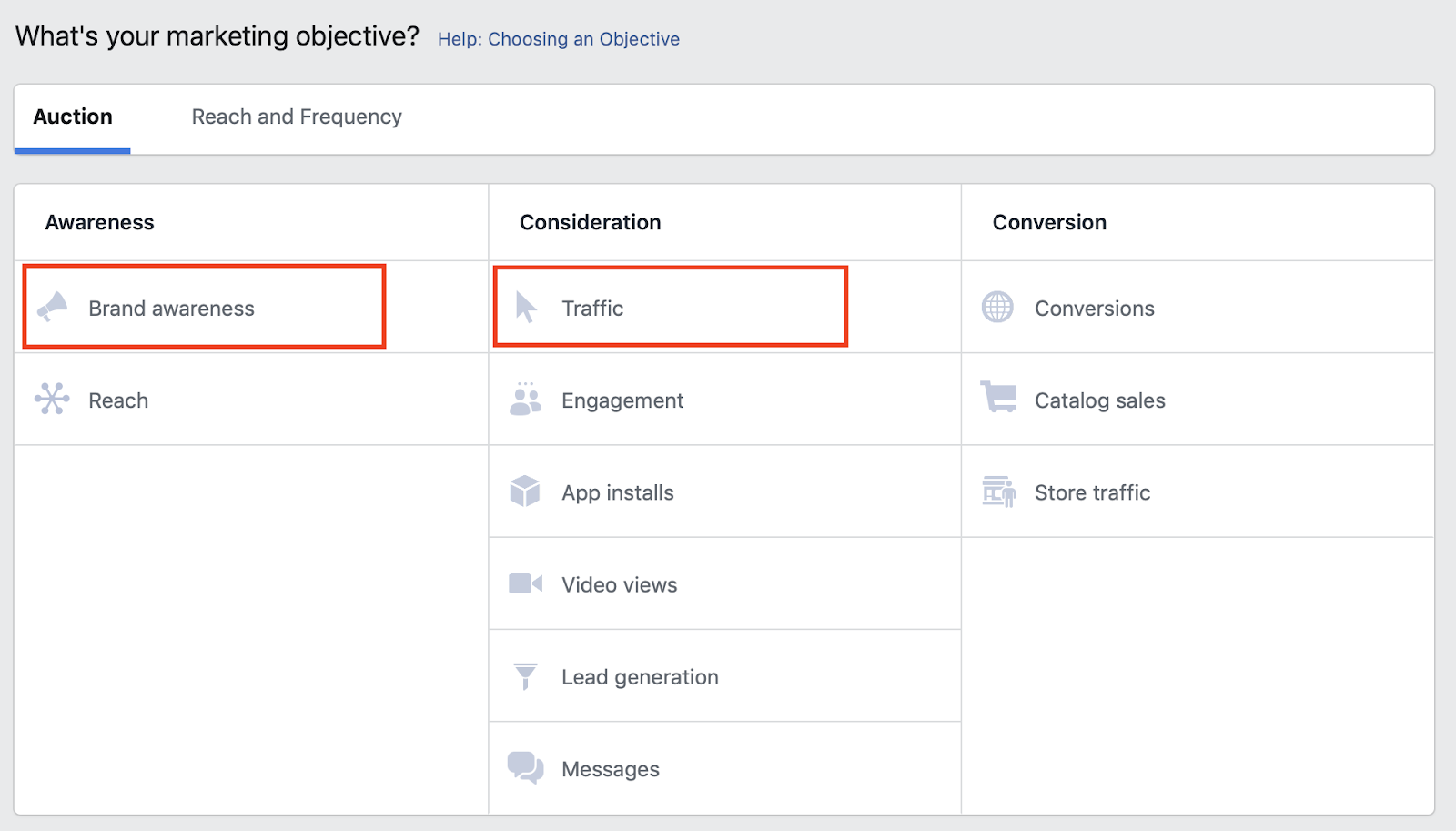
Run both Brand awareness and Traffic campaigns
Traffic campaigns – Facebook will optimize your ad delivery to get the maximum number of traffic to your website.
Awareness campaigns – Facebook’s algorithms will try to reach the feeds of thousands of people, with the goal to make them aware of your brand (they don’t necessarily need to click on your ad, just see it and remember the brand).
There’s one more difference: We generally see the best results when using static image ads in Traffic campaigns while in Brand Awareness campaigns, video ads work wonders.
Facebook explicitly suggests brands to produce video content given their high engagement rate. For example, this Sephora campaign resulted in a 41% higher click-through rate than their previous ads.
Video ads often have higher engagement – Image source
Here’s are some best practices for your brand awareness video ads:
- Make your Facebook video ads FAST as people’s attention span is short.
- Introduce your product and explain the benefits.
- Use special effects and introduce many colors to catch the viewer’s attention.
8. Kick-off your viral content with Facebook ads
Burger King is famous of their advertising campaigns trolling McDonald’s.
In one of their most recent campaigns, Burger King asked people to go to McDonald’s in order to unlock a 1-cent Whopper deal.
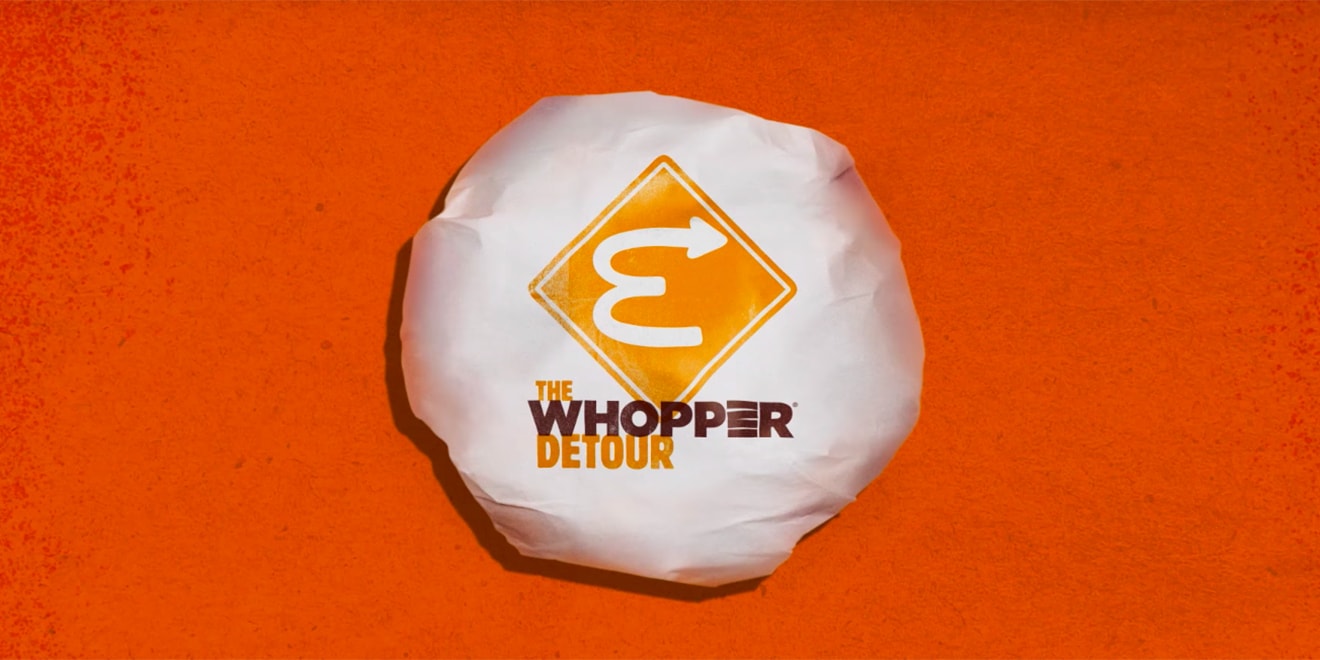
Burger King’s Whopper Detour campaign – Image source
As expected, the campaign went viral, resulting in thousands of Whopper sales and the earned media reaching tens of millions of people.
But each viral marketing campaign needs some help to get going. And that’s where Facebook ads come into play.
If you need to give an extra boost to your big-scale advertising campaign, you can set up a Facebook Brand Awareness campaign to ensure the message reaches the critical amount of people for a viral take-off. 🚀
🤝 Facebook PPC strategies for closing more sales
Now that you’ve got thousands of people aware of your brand and products, it’s time to convert the website visitors into customers.
Up next, you sill find a list of handy Facebook ad strategies we’ve seen working times over.
9. Set up Facebook remarketing campaigns
Remarketing ads are a vital component of every successful Facebook PPC strategy.
Only a handful of people convert on the first website visit. To turn the remaining 99% of visitors into customers, you should set up a Facebook retargeting campaign.
The easiest Facebook remarketing audiences to get started with are:
- Past website visitors
- People who have interacted with your Facebook page and ads
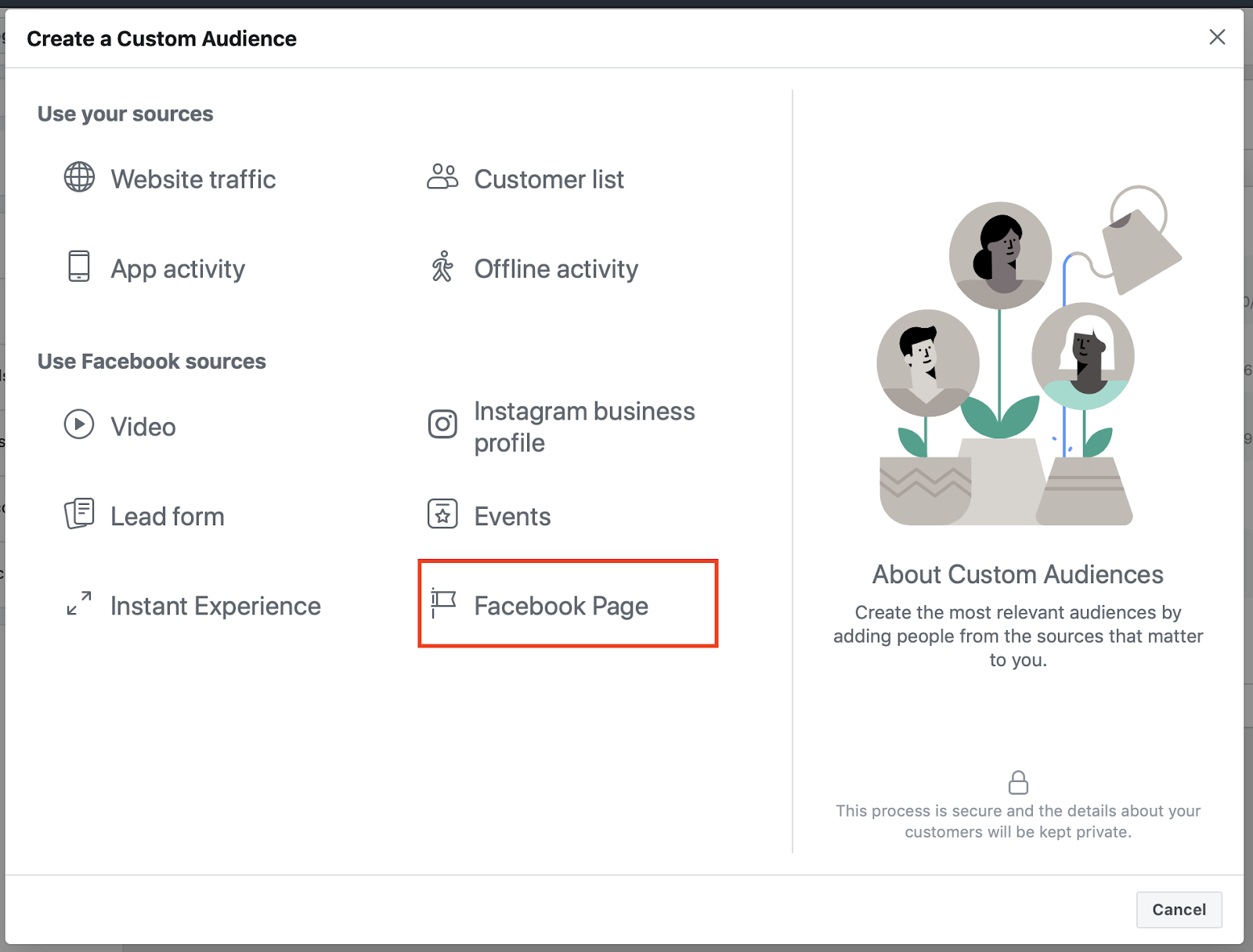
Retarget people who have engaged with your Facebook page
10. Set up dynamic Facebook remarketing campaigns
Dynamic Facebook ads let you set up ads that automatically advertise the most relevant products to each person in your target audience.
To run dynamic Facebook ads, you will need to set up a Product Catalogue that’s linked to your website, so that Facebook will know which product pages a user has previously visited and can personalize the ads accordingly.
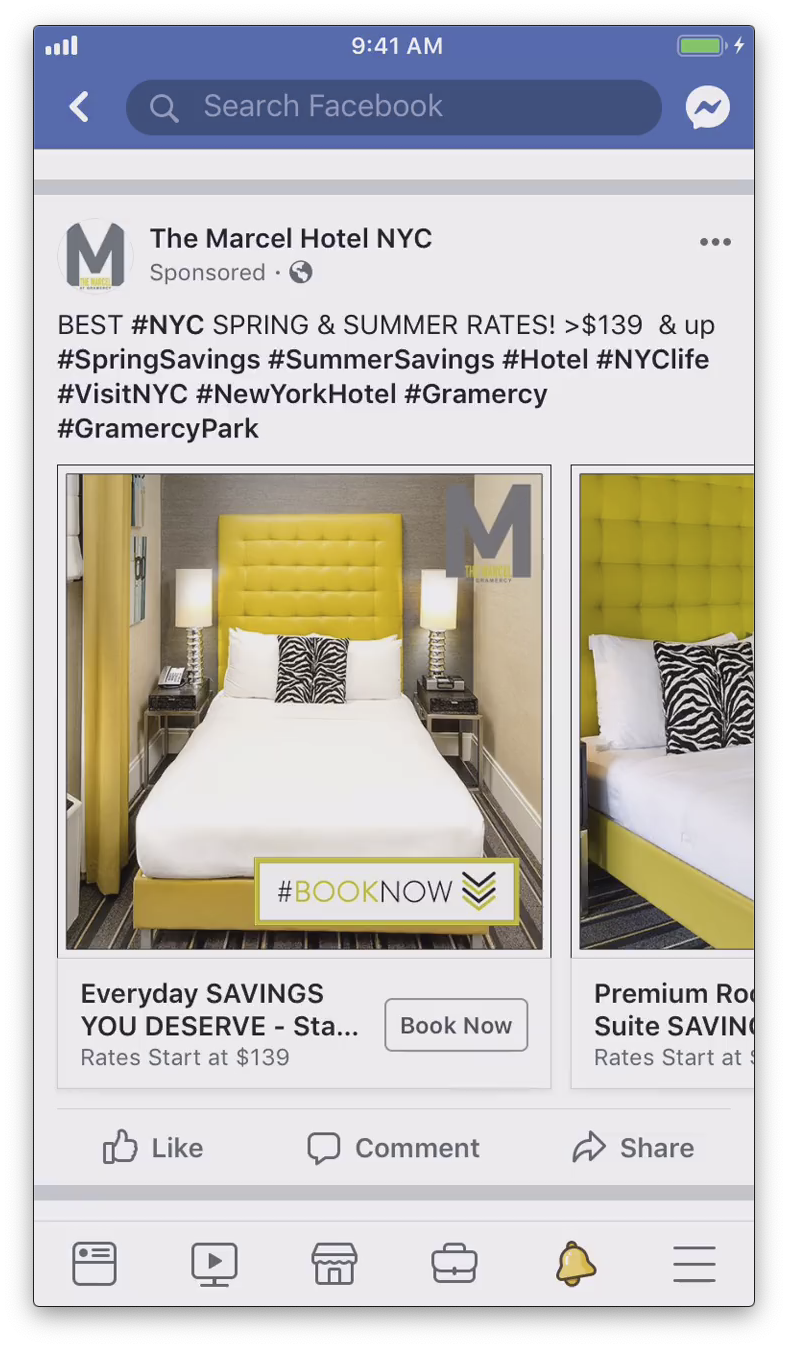
Example of a dynamic Facebook ad
Tip: In addition to setting up Facebook remarketing ads, create a Google remarketing campaign to run on the side – you can reach your high-value audiences on more platforms.
11. Turn leads to customers with a discount offer
Sometimes, all it takes to nudge your potential clients to complete the purchase is a small discount.
Test running Facebook remarketing ads that promote a (limited-time) promo offer, e.g. -20% off on a specific product line.
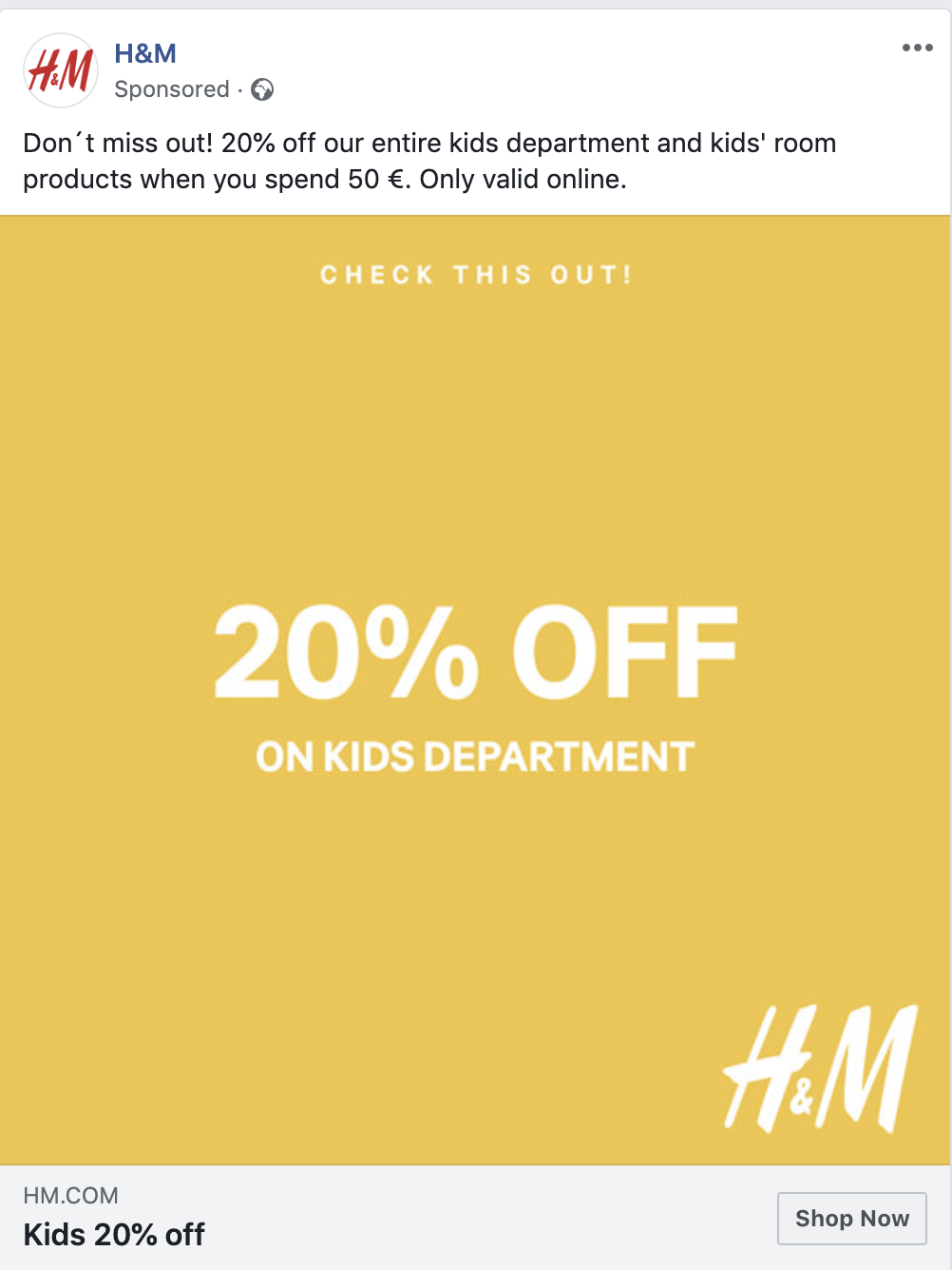
H&M is offering a small discount
Here’s another example from Teabox, discounting part of their tea collection.
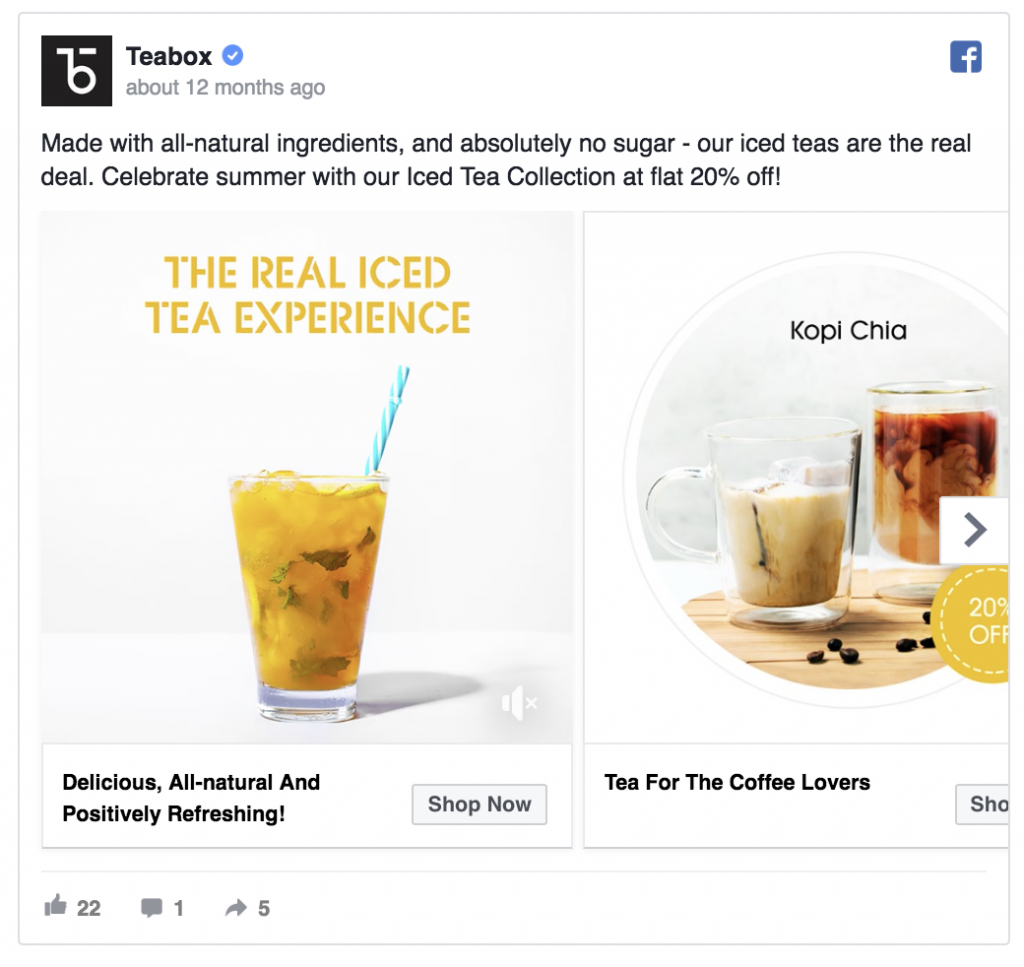
This ad from Teabox is super cool 🧊
Not sure where to get started? Here are some discount offer ideas for your Facebook remarketing campaigns:
- Offer a flat 10% or 20% discount on all products.
- Advertise a promo code, e.g. “Get €10 off your first purchase with promo code WELCOME10.”
- Discount selected products by 50% for a limited-time sales period.
12. Promote free shipping on all orders
Another efficient offer for promoting to your Facebook remarketing audiences is free shipping.
By offering free delivery, you’re removing one of the consideration points in the purchasing process.
Tip: If you don’t want to end up losing money on free shipping, set a minimum order value.
Here’s an example by The Sill: you can get free delivery on orders over $100. Not only will the free shipping encourage people to order plants, but they are also more likely to make bigger purchases to reach the $100 threshold.
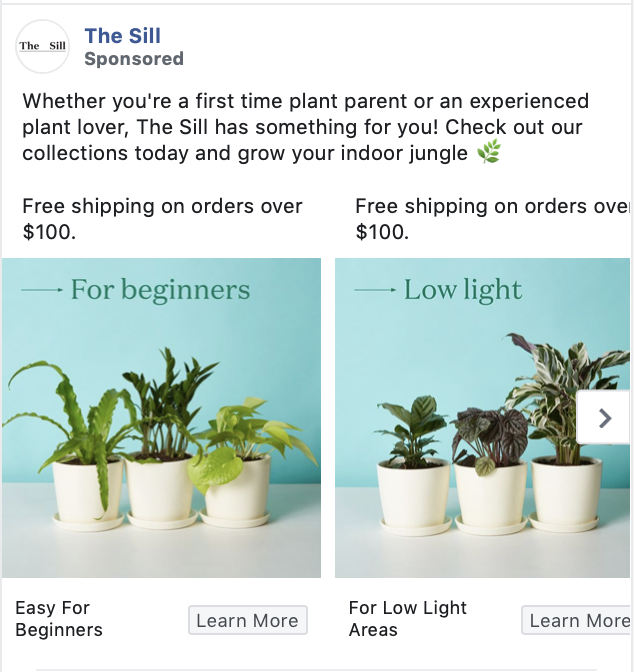
The Sill’s Facebook ad example
13. Offer free product samples/welcome kit
For brands selling a subscription service, a new customer can mean revenue for many months to come. Which means that you can also invest more in acquiring the clients with a high lifetime value.
For example, Blue Bottle Coffee advertises a free welcome kit for people to get familiar with craft coffee.
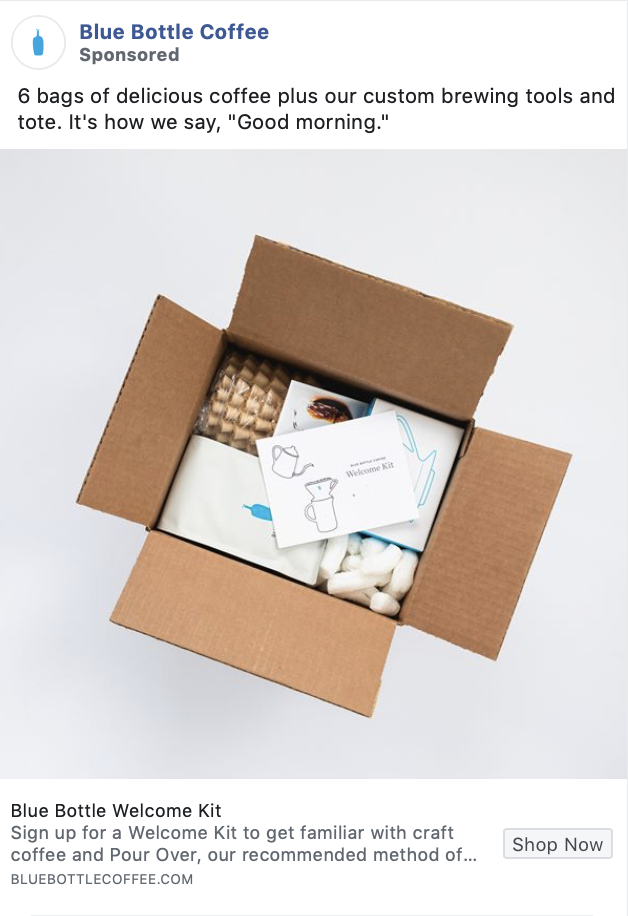
We’re going to check it out!
But it’s not only the consumer products that can benefit from offering free product samples. MOO, an online print shop, is offering a free sample kit of their papers and finishes.
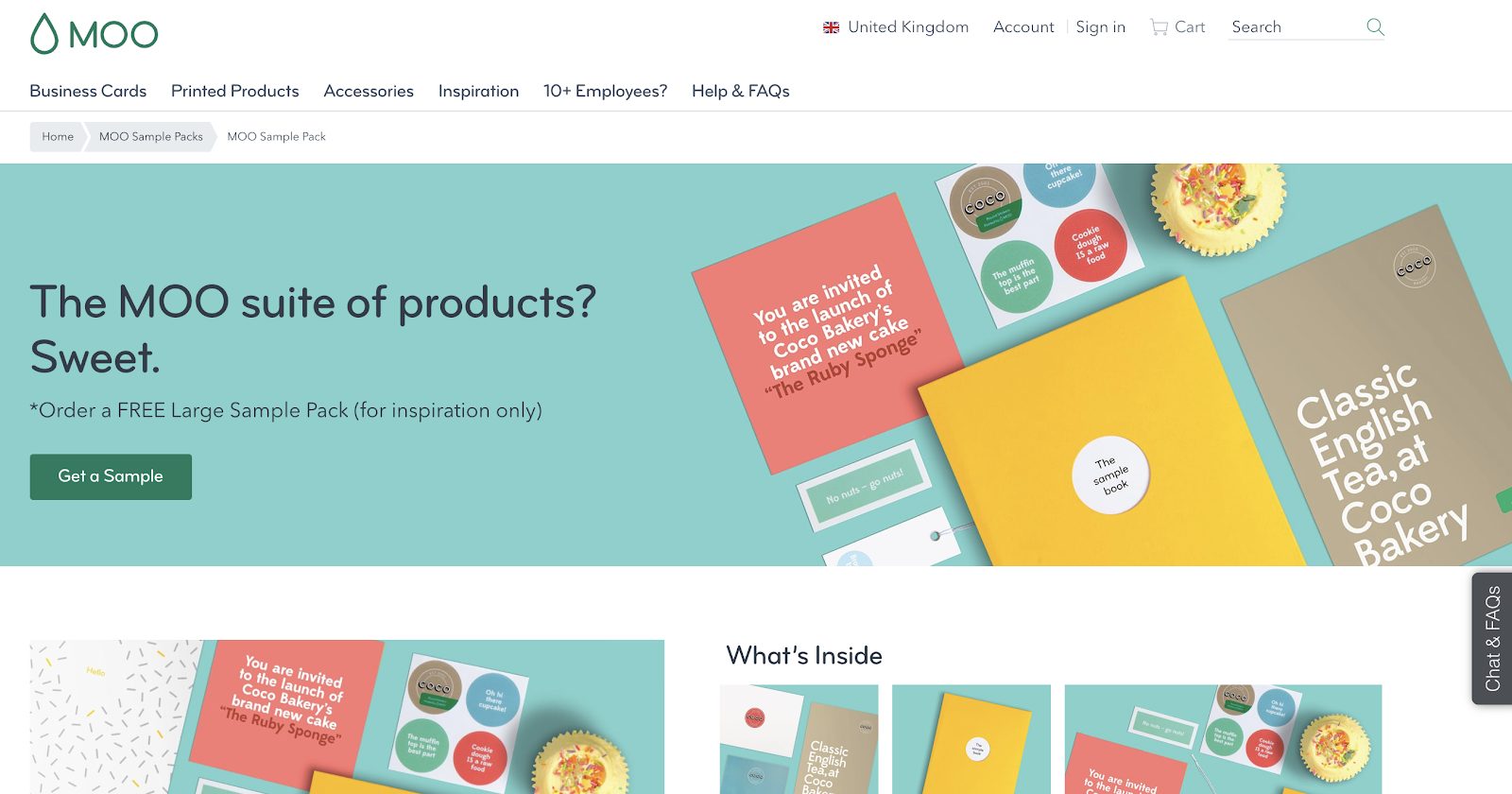
You can get a sample pack 100% for free
In the case of B2B Facebook ads, free product samples can be replaced with the following offers:
- Free business consultation
- Free auditing service
- Free 1-month trial period
14. Build a loyal blog readership with Facebook ads
Building a loyal blog readership is a combination of publishing high-quality articles, smart SEO tactics, and continuous advertising.
On top of developing an email list where you can notify your followers about all new blog posts, you can also run a Facebook PPC campaign.
This way, you can reach all your past blog readers, making them stay in the marketing funnel long enough to develop a habit of reading your blog.
Here’s how it works:
- You promote your blog article on Facebook.
- The next time you publish a blog article, you will promote it to the previous articles’ readers in addition to new audiences.
- Your target audience is less likely to miss out on the newest additions to your blog.
Here’s an example by Pipedrive: they share each of their new blog article on Facebook.
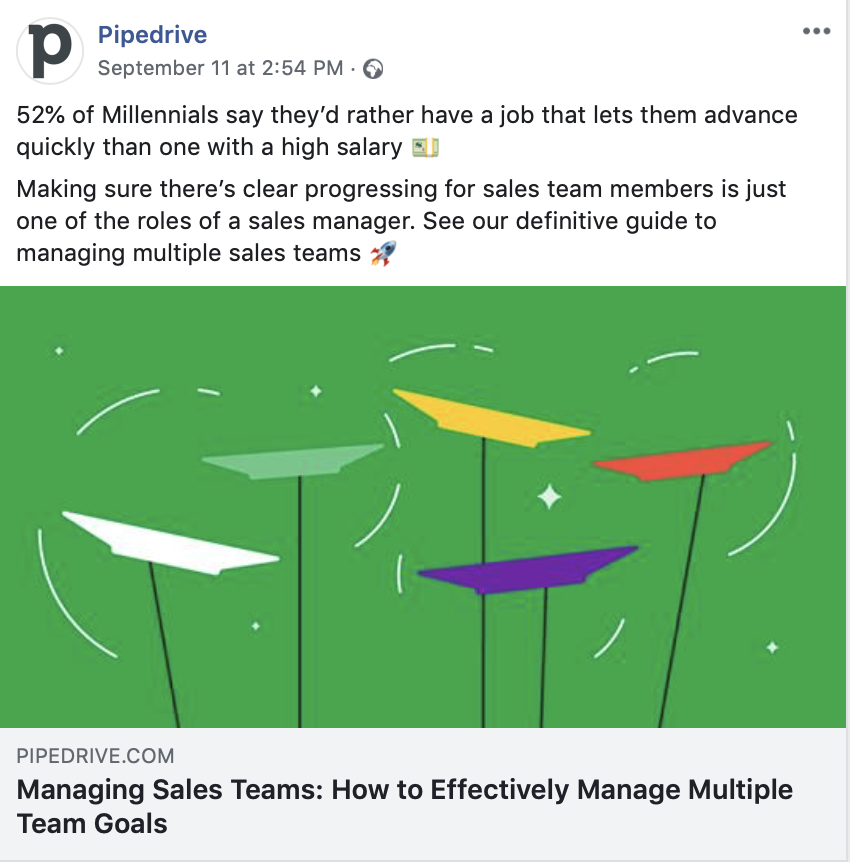
Pipedrive shares all blog articles on Facebook
The next time they publish an article, they could target a Facebook Custom Audience of past 30 days’ blog readers.
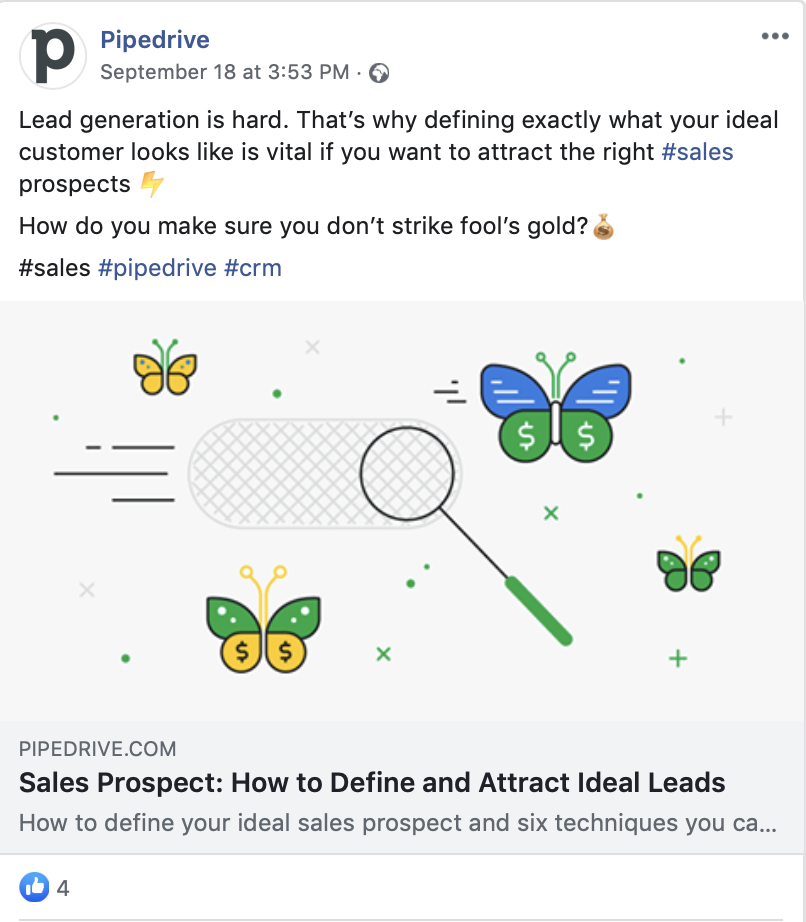
This post could retarget past blog visitors
Setting up a Facebook audience of past blog readers is easy: Simply add Facebook Pixel to your website and you can create a Custom Audience of the people who have visited your blog URL in the past 30 days.
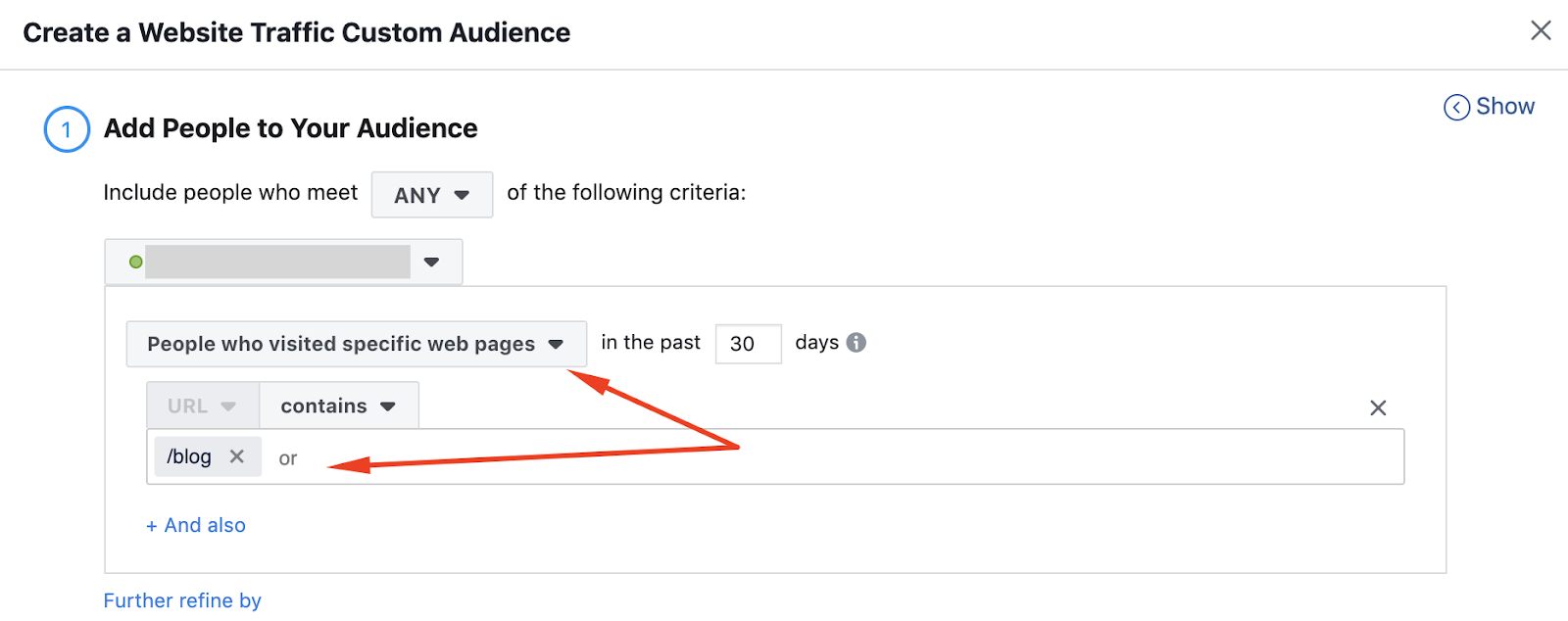
Set up a Facebook audience of blog readers
15. Run Facebook ads to close B2B sales deals
Big-scale business deals are often a result of many months of marketing and sales combined.
However, there are ways to support your sales team’s work with Facebook ad campaigns. For example, by targeting the users at the end of your sales funnel with ads that help to seal the deal.
Here’s a list of Facebook ad messages that you could advertise to help close sales deals:
- Case studies and customer success stories – to convince the decision-makers that your product/service is worth the money. (the Intercom ad example below)
- Free trial extensions – to offer potential customers another week or month of the free trial period.
- Limited-time discount offers only available if a B2B customer commits to a long-term contract.
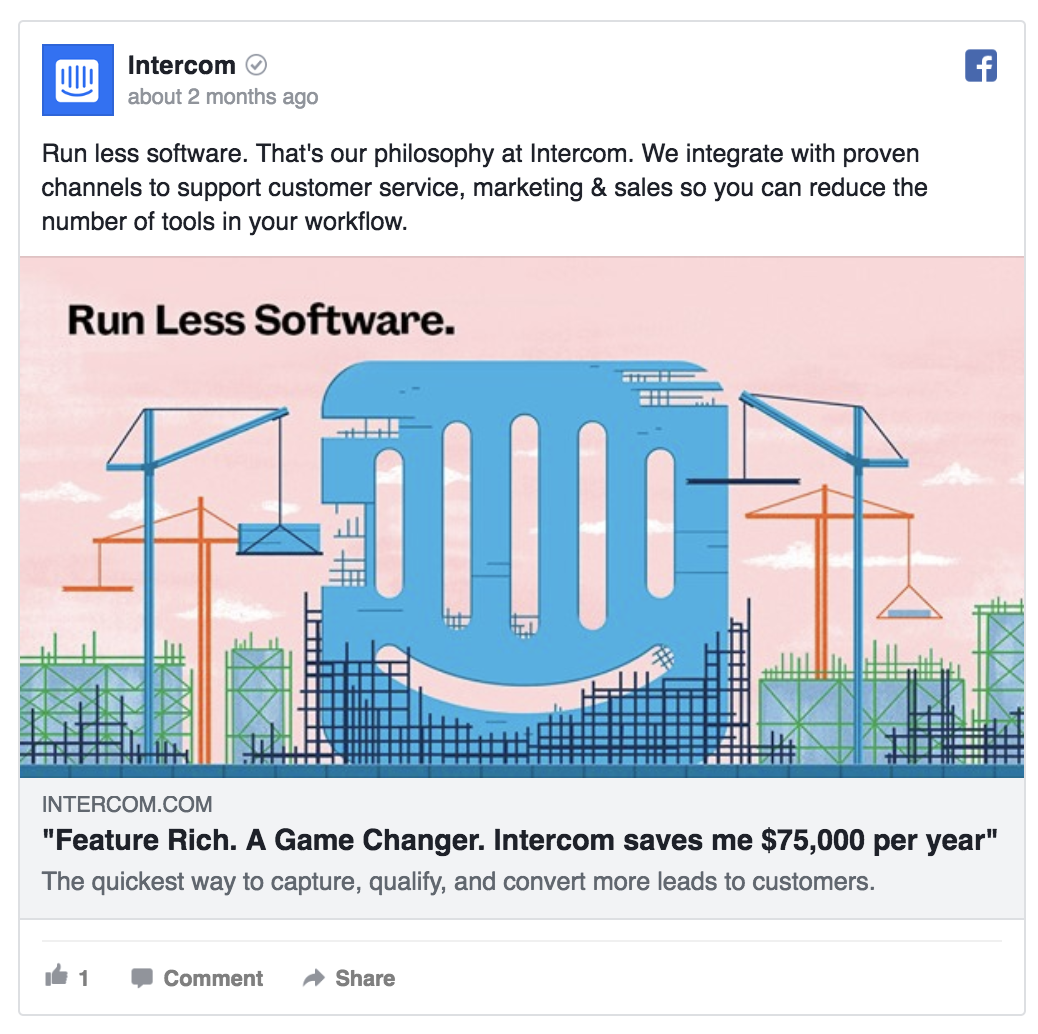
Intercom is advertising a customer success story
If you’re marketing an online B2B service or tool, you can set up the following Facebook Pixel events to help track ad results:
- Free trial signup
- End of the free trial period
- Purchase of a paid subscription
All of these are Facebook Standard events that can also be used for creating Custom Audiences.
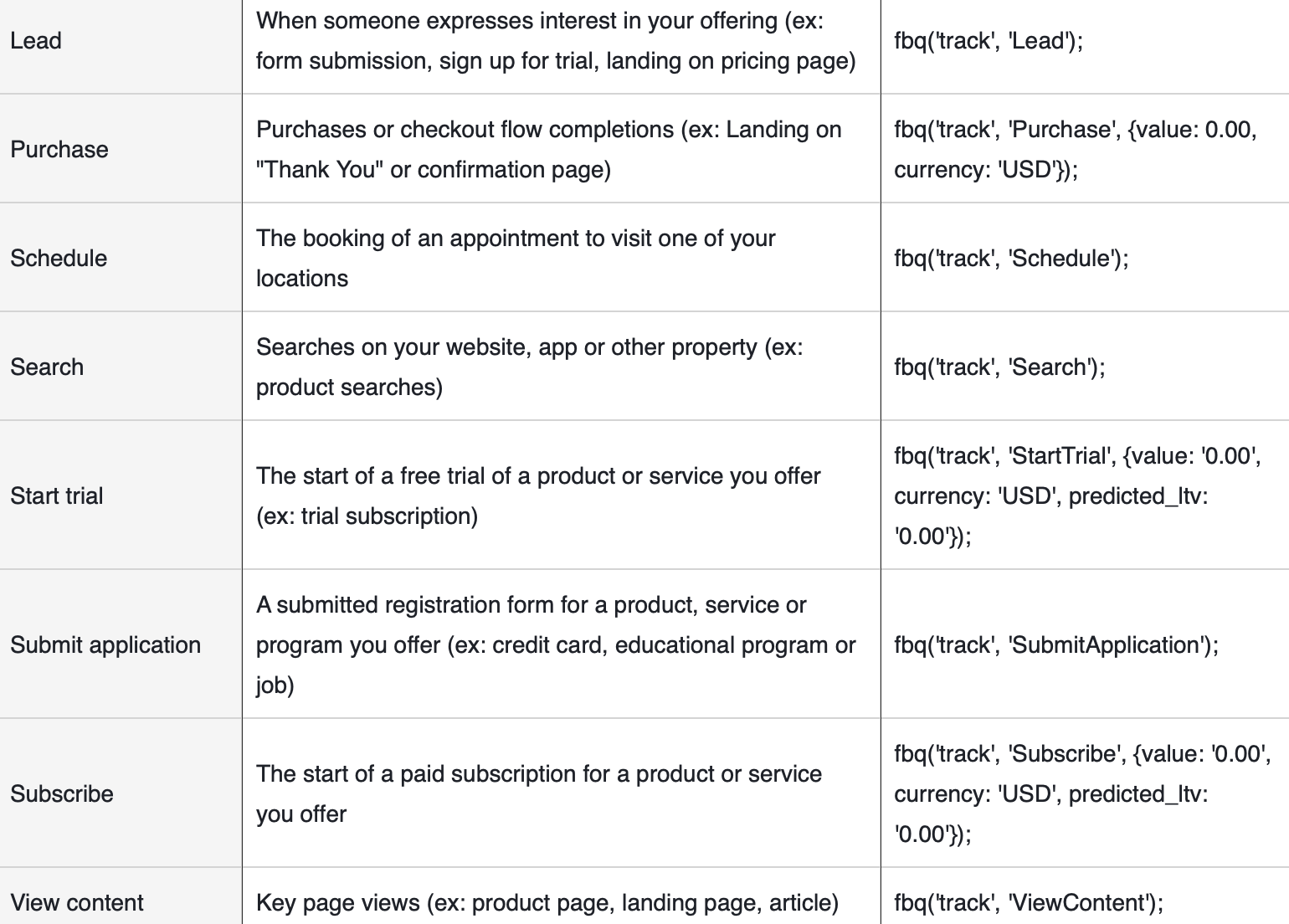
Facebook Standard Events
For this type of Facebook ad campaign, we recommend using the Daily Unique Reach delivery method, so that your ads reach the target audience once per day.
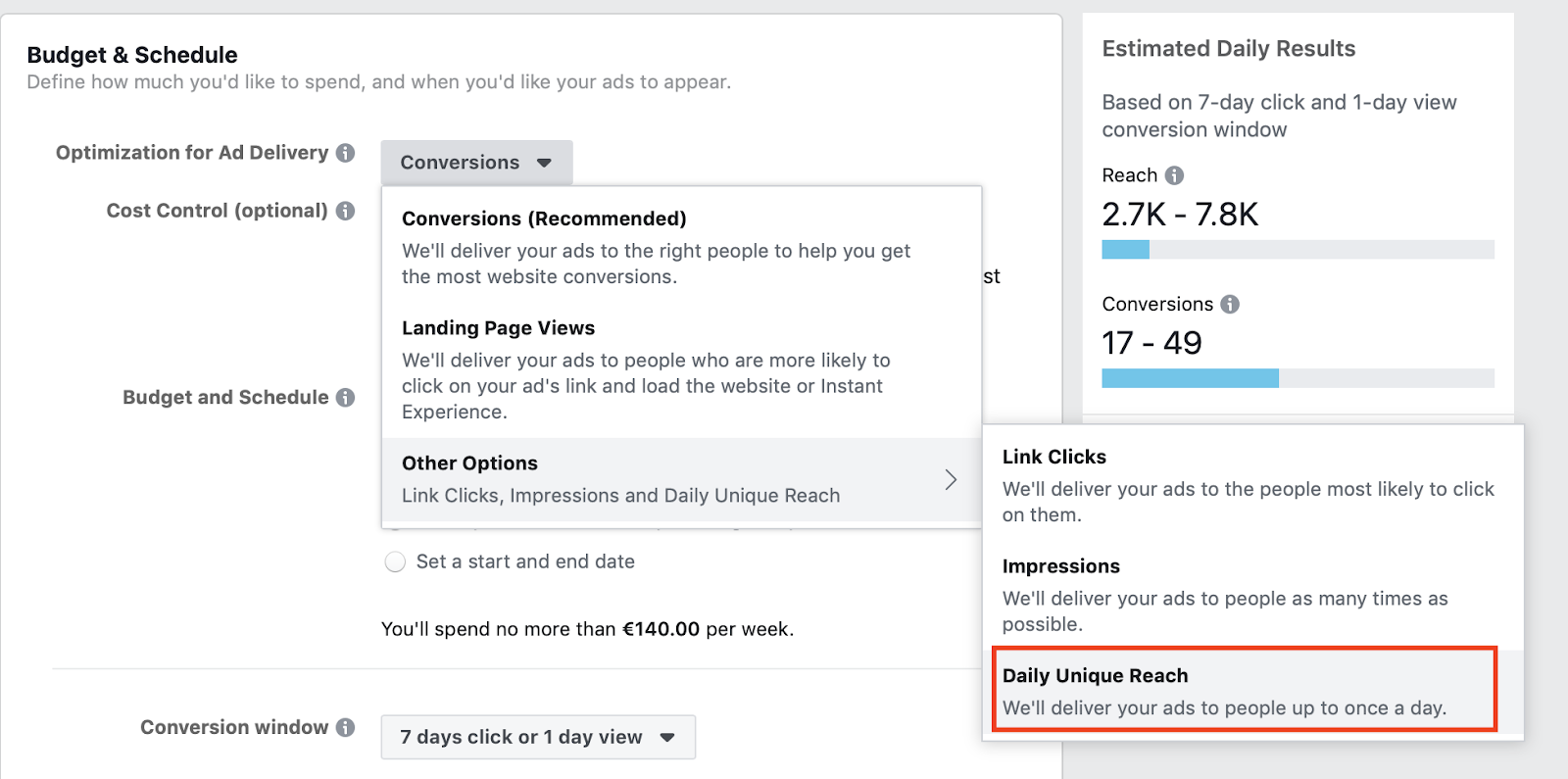
Use the Daily Unique Frequency ad delivery option
16. Bring back the shopping cart abandoners
Shopping cart abandoners are people that have been shopping in your online store, added some items to their cart, but then left your website without completing their purchase.
Shopping cart abandoners are a super valuable segment as they have shown a clear interest in buying your product. Based on Statista, as many as 80% of people abandon their shopping carts.

Shopping cart abandonment rate can be up to 80% – Image source
One of the best ways to convince cart abandoners to return to your online store is to offer them a discount or a coupon. Try to make the offer personalized and limited-time.
How to set up the remarketing audience of shopping cart abandoners:
To reach people who have abandoned their shopping cart with Facebook ads, create a Custom Audience based on website events. E.g. you can use Google Tag Manager to set up an event on your website that records a person clicking on the “Add to Shopping Cart” button.
⭐ Facebook PPC strategies for keeping your customers engaged
If you’re not focused on making your existing customers commit repeat purchases, you’re missing out on a LOT of revenue.
According to some resources, the probability of selling to a new prospect is 5-20% while the probability of selling to an existing customer is 60-70%.
And based on eMarketer’s data, almost three out of five U.S. online buyers said they spot ads for products they’ve previously looked up.
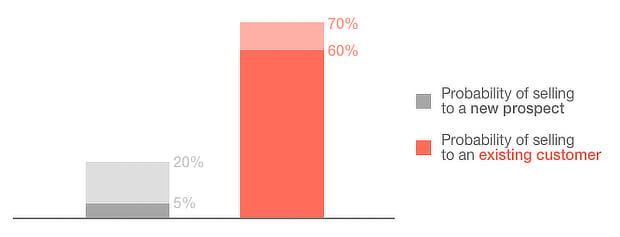
It’s much easier to sell to existing customers – Image source
There several ways to increase your sales by advertising to your existing user base, including the tactics of upselling and cross-selling. And on top of that, you can also figure out when your clients are running out of your product, and target them with Facebook ads just in time they want to restock.
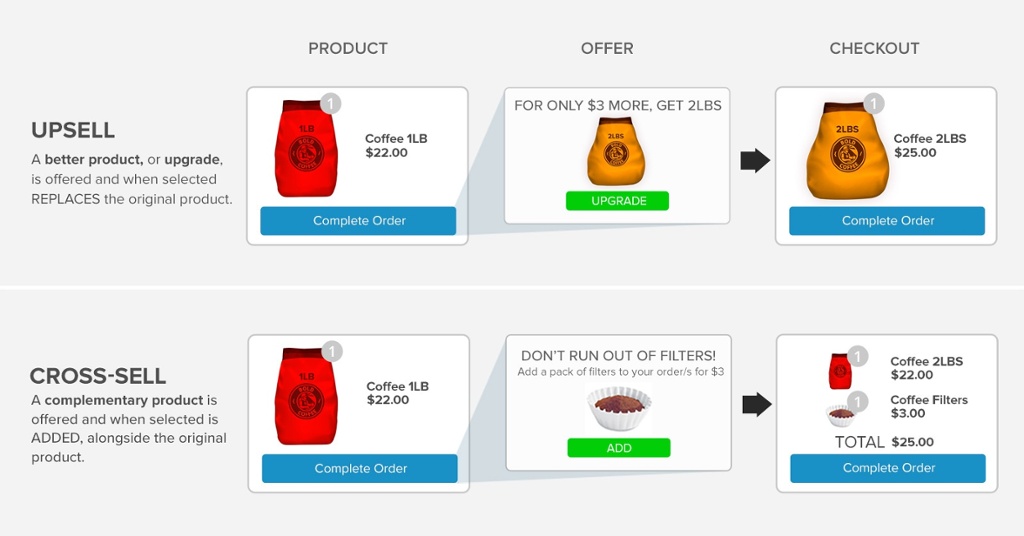
There’s value in both upselling and cross-selling – Image source
Up next, you’ll find Facebook PPC strategies for advertising to your existing user base, in order to take full advantage of the audiences you’ve built throughout the marketing funnel.
17. Set up Facebook remarketing ads to past purchasers
Advertising to your existing customer base on Facebook is a powerful way to remind them of your brand and to inform them about your latest products.
For example, a fashion brand could promote their new collection while a B2B business could run ads about the new services they provide.
GoPro uses another fascinating tactic to get their previous product’s owners to upgrade to the latest device. They offer to sell the new camera at a $100 discount when a client returns an older model.
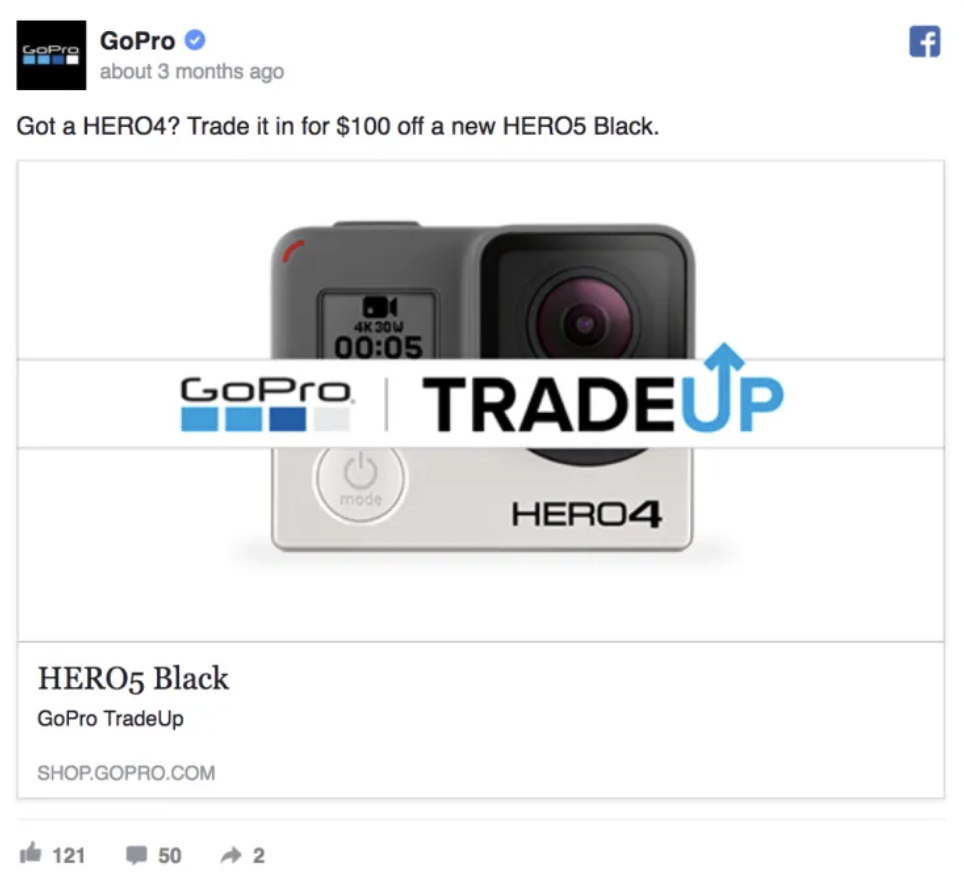
GoPro invites users to switch to the latest model
To create a remarketing audience for upselling, set up Facebook Custom Audiences based on purchase events.
Tip: Don’t forget to exclude people who completed the purchase from your remarketing audience.
Make sure that your audience doesn’t get tired or overwhelmed with seeing your ads too often

When seeing the same ad for the 10th time – Image source
Once a customer has made a repeat purchase from you, you should exclude them from your Facebook ad audience for a while. Set up a Custom Audience of people who have completed the purchase in the past 14 or 30 days and exclude those people from your remarketing or upselling ad campaign.
18. Keep your customers informed about your brand
Another way to put Facebook ads into good use is to spread the word about your latest company news or positive media coverage about your brand.
For example, Uber is using Facebook as a channel for educating the riders on how to have safer trips and to show that they’re committed to safety.
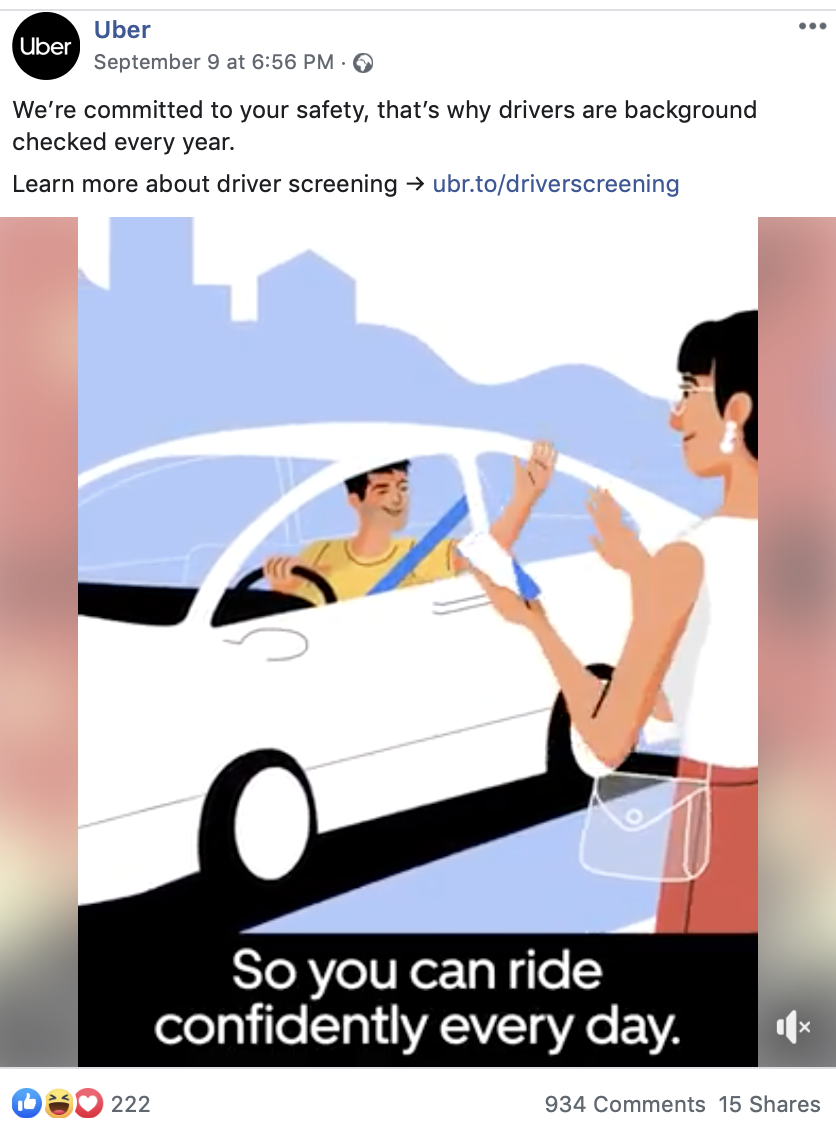
Uber Facebook Post #1

Uber Facebook Post #2
Uber’s Facebook posts on safety
You can publish your company updates or educating posts as Facebook page posts and promote these to your existing user base.
19. Share high-value content with existing users
There’s a bunch of reasons why to keep advertising to your existing user base.
One of them is that those people are your potential brand ambassadors and can help to spread the word about your product. 😉
A tried and tested way to bring more value to your audience is to share relevant content, including white papers, blog articles, reports, and more. (And what better channel for quickly promoting these than Facebook ads.)
For example, Hired is promoting an industry report about salaries in 2019. Not only is it an interesting read for their users, but it is also highly shareable.
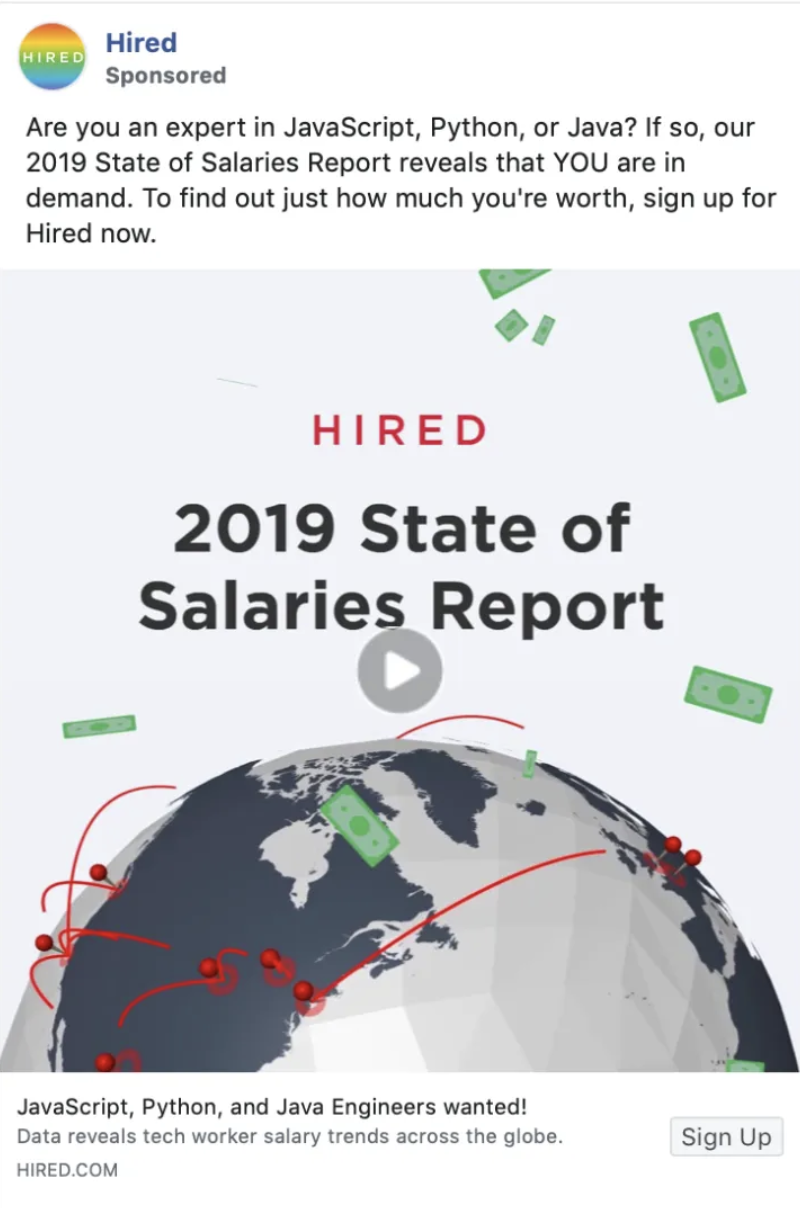
Hired is promoting an industry report
Here’s one more Facebook ad strategy to test:
Whenever you’re promoting a blog article or another type of content on Facebook, create 2 ad sets for the promotion:
- One ad set should target a wide audience that hasn’t previously interacted with your brand (to bring new users to your marketing funnel).
- Another ad set should target your existing customer base as they are the ones who will like and share your post, helping to increase its reach and through that, reduce the cost-per-click of the promotion.
20. Use Facebook ads to gain more followers
Having a high number of page likes on Facebook and thousands of followers on Instagram helps to build trust around your brand.
Instagram Stories is the last placement in the Facebook ecosystem that reaches 100% of your followers – use this channel while you can and grow your Instagram followership to reach more people.
Here’s an example of an Instagram giveaway that lets two people win free plants in exchange for following the Instagram page and tagging a friend.

Instagram giveaway example by @wtfoliage
You can also run giveaway campaigns regularly to engage your existing users.
Here are some more tips for setting up your giveaway posts and making sure people will engage with these:
- Add the call to action “win X” or words “giveaway” in the ad visual, so people will immediately understand that they can win something.
- Make it a condition that people need to tag 2-5 friends in order to participate in the draw.
- Mention a specific date of when the winner will be announced to create trust and get people to comment.
- Ask people to also follow your page to get included in the final draw.
Follow the above rules ad you’re 99% guaranteed to get new followers. 🚀

Who wouldn’t want to win – Image source
15 Facebook PPC hacks for doubling your results at no extra cost
Now that you’re aware of the most popular Facebook PPC strategies used by online marketers around the globe, you’re almost set to start working on all those campaigns.

High five! – Image source
But before you go, take five more minutes to read through some tricks and hacks that help to improve your campaign results and lower the cost-per-click, resulting in more results.
1. Always use the Campaign Budget Optimization
When setting up your Facebook ad campaign, select the “Ad budget optimization” option to have Facebook automatically distribute the ad campaign budget between ad sets, so that your best-performing ad sets get more budget to spend.
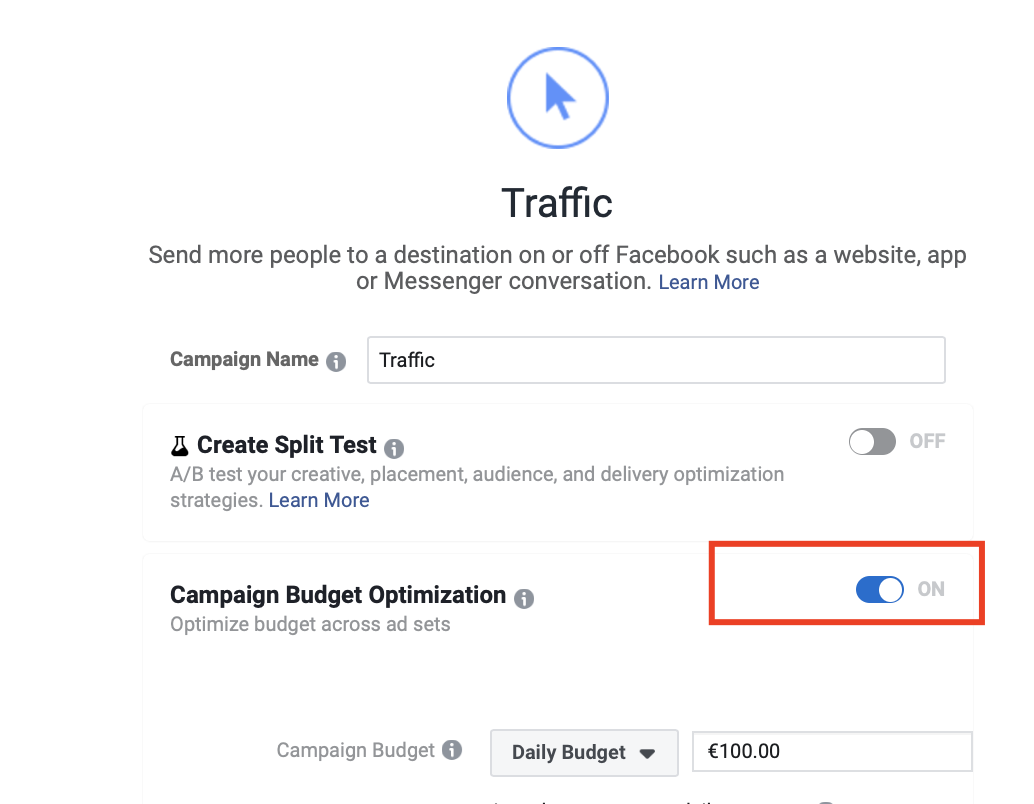
Turn on the Campaign Budget Optimization
2. Don’t be lazy about A/B testing your ad creatives
Every time you set up a new ad campaign, include multiple ad visuals to learn which ones work best. Then double down on the best-performing creatives.
A study of 37,259 Facebook ads found that most brands only run a single Facebook ad, but the TOP best-performers have got hundreds.
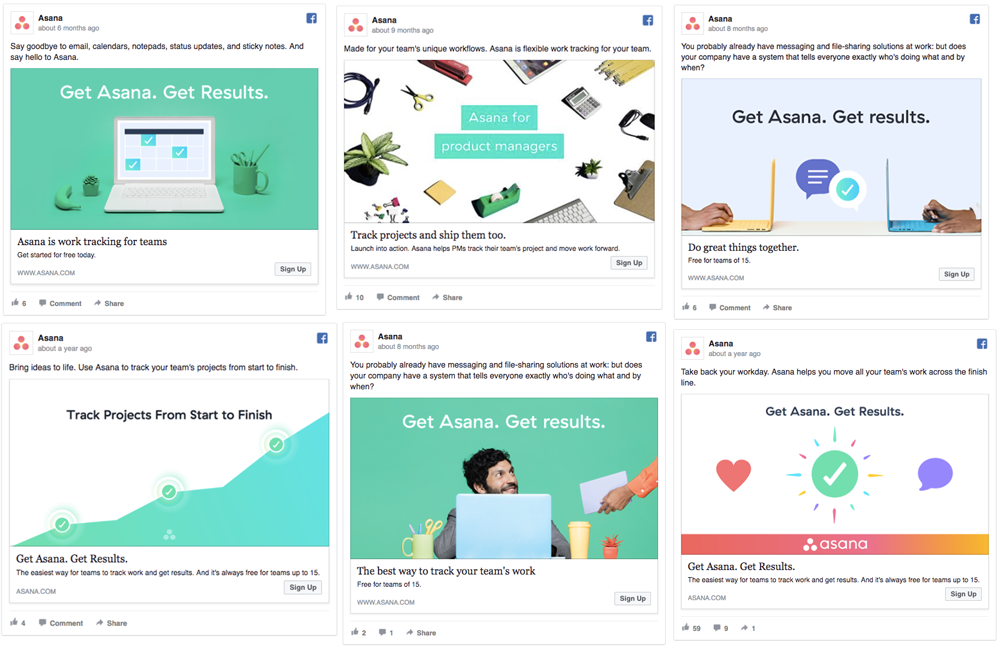
Asana uses a lot of various Facebook ad creatives
3. Use value-based campaign optimization
Use this Facebook Ads Manager feature to show your ads to people who are likely to maximize the amount of value they generate. Learn more here
4. Select the correct campaign optimization goal
When setting up a new Facebook PPC campaign, you’ll have plenty of goals to choose from. The best practice is to select the option that’s closest to your real objective. E.g. if you want to get additional website traffic, select “Traffic.” If your end goal is to make people purchase a product on your website, select the “Conversions” objective.
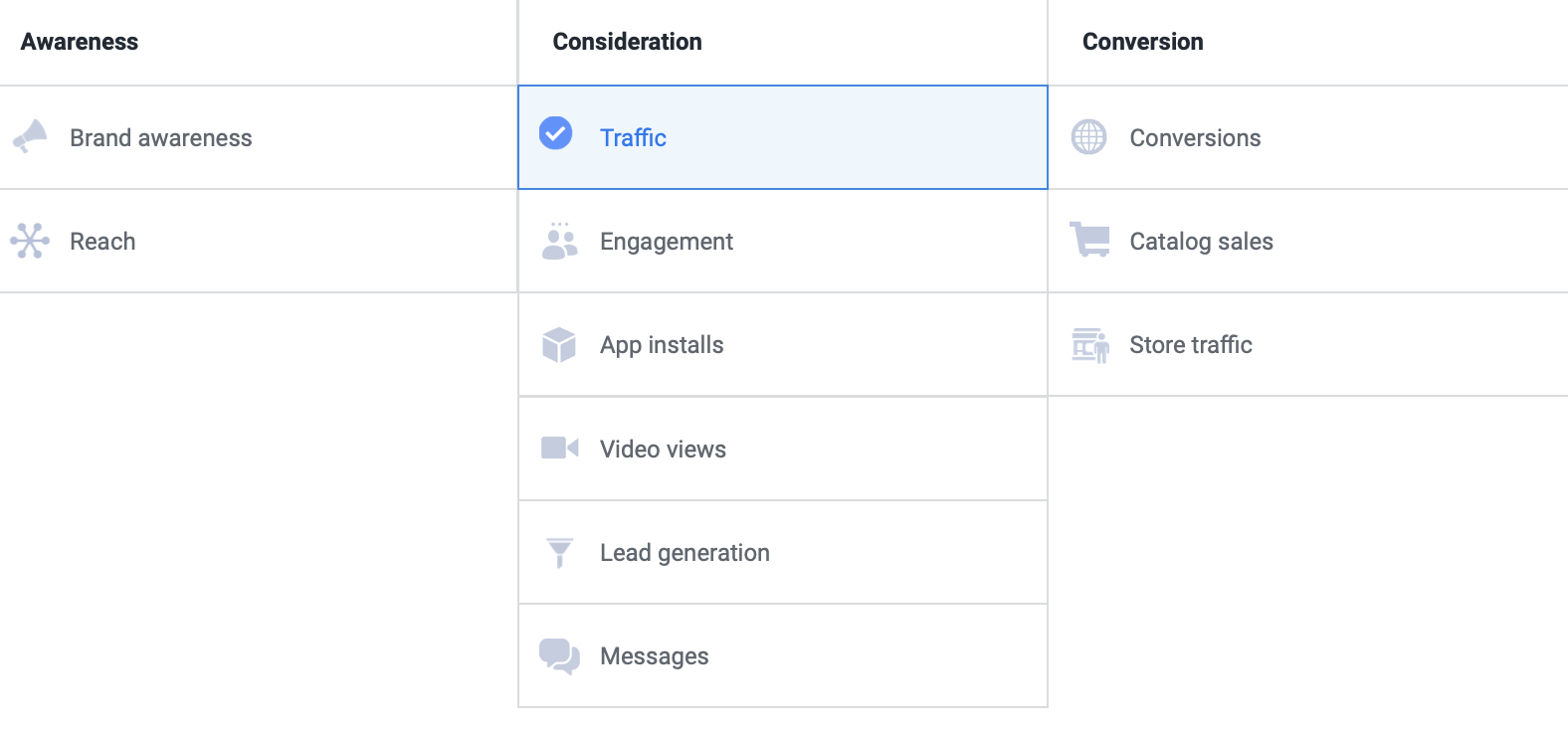
Select the right ad campaign objective
5. Add the correct ad creative format for each placement
If you’re planning to advertise on the Facebook news feed, Instagram feed, and Instagram Stories at the same time, remember that all those ad placements work best if you add a custom-sized creative for each.
We recommend uploading at least 2 creatives: 1080 x 1080 pixels (for Facebook and Instagram feeds) and 1080 x 1920 pixels (for Instagram Stories)
You can add multiple image sizes per ad by clicking on “Select a placement to customize” in the ad editing view.
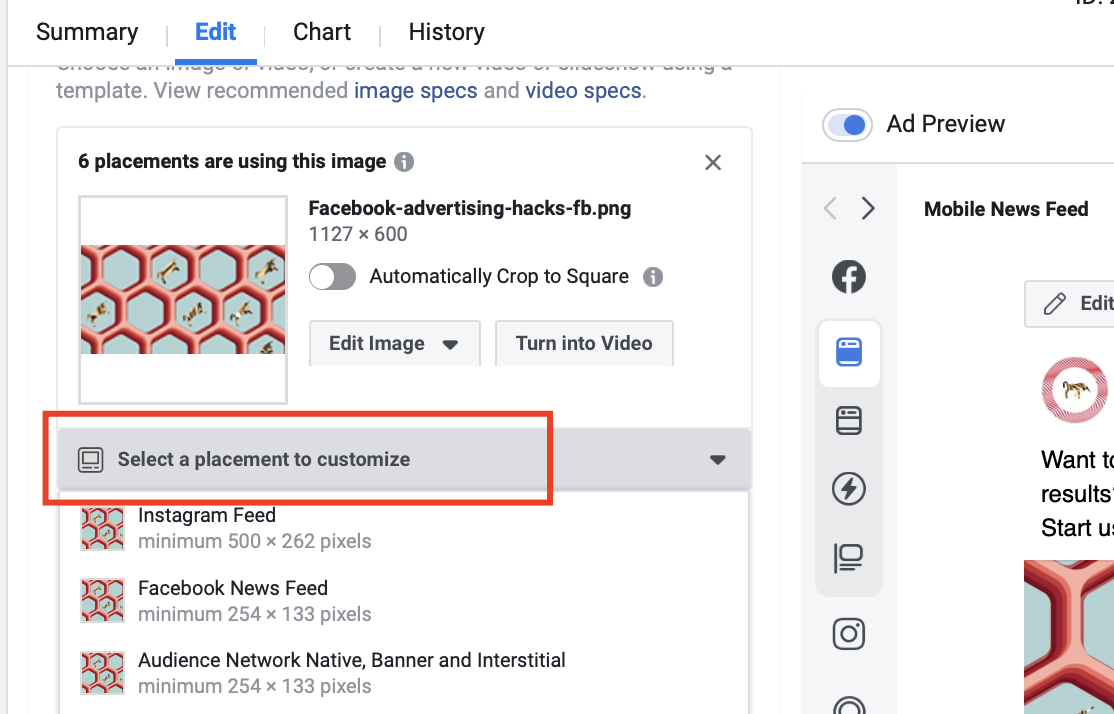
Add different creatives per placement
6. Keep your ad image’s text low
If you’ve been advertising on Facebook for a while, you may remember a Facebook rule that punished ads that had more than 20% text in their ad creative.
Yep, if you had too much text in the image, Facebook could lower reach, resulting in higher ad costs.
You would see a similar warning when uploading your ad images to the Ads Manager.

This ad has too much text in image
In 2020, Facebook quietly sunsetted the ‘<20% text in image’ rule along with the Text Overlay tool used to scan for text-heavy ad creative.
Despite the formal change to this rule, we (and Facebook) have observed that ads perform better when the creative keeps image text to a minimum.
Tip: We generally see good results with the Low-level in-image text level reported by Facebook, so do not worry too much if your ad creative gets the Low-level text warning.
7. Combine static and video ad creatives in the same ad set
A report by Kinetic Social showed that video ads get the lowest eCPC, with an average eCPC of $0.18. Also, Facebook is recommending advertisers to run video ads for higher engagement.
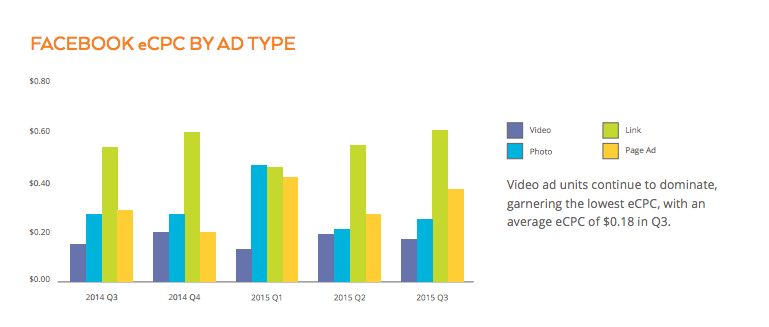
Video ads can work wonders – Image source
However, sometimes we’ve still seen static image ads outperform the video ads. It’s almost impossible to predict what will work for your brand.
This said, you could add both a video and a static image ads creatives into the same Facebook ad campaign to see what works best on your audience.
8. Always add captions to your video ads
The videos in Facebook news feed play without sound by default. So it is absolutely critical that you add captions under each video where there’s a voiceover.
According to Facebook, adding captions will increase video view time by an average of 12%. Another study of Facebook video ads reported that 41% of videos were basically meaningless without sound.
9. Add website links also in the ad copy
Here’s a small hack that can help you get more clicks on your Facebook ads. 💁
On top of having your entire ad creative clickable (how Facebook ads work by default), also add a link to the destination URL inside the ad copy as some people might prefer to click there.
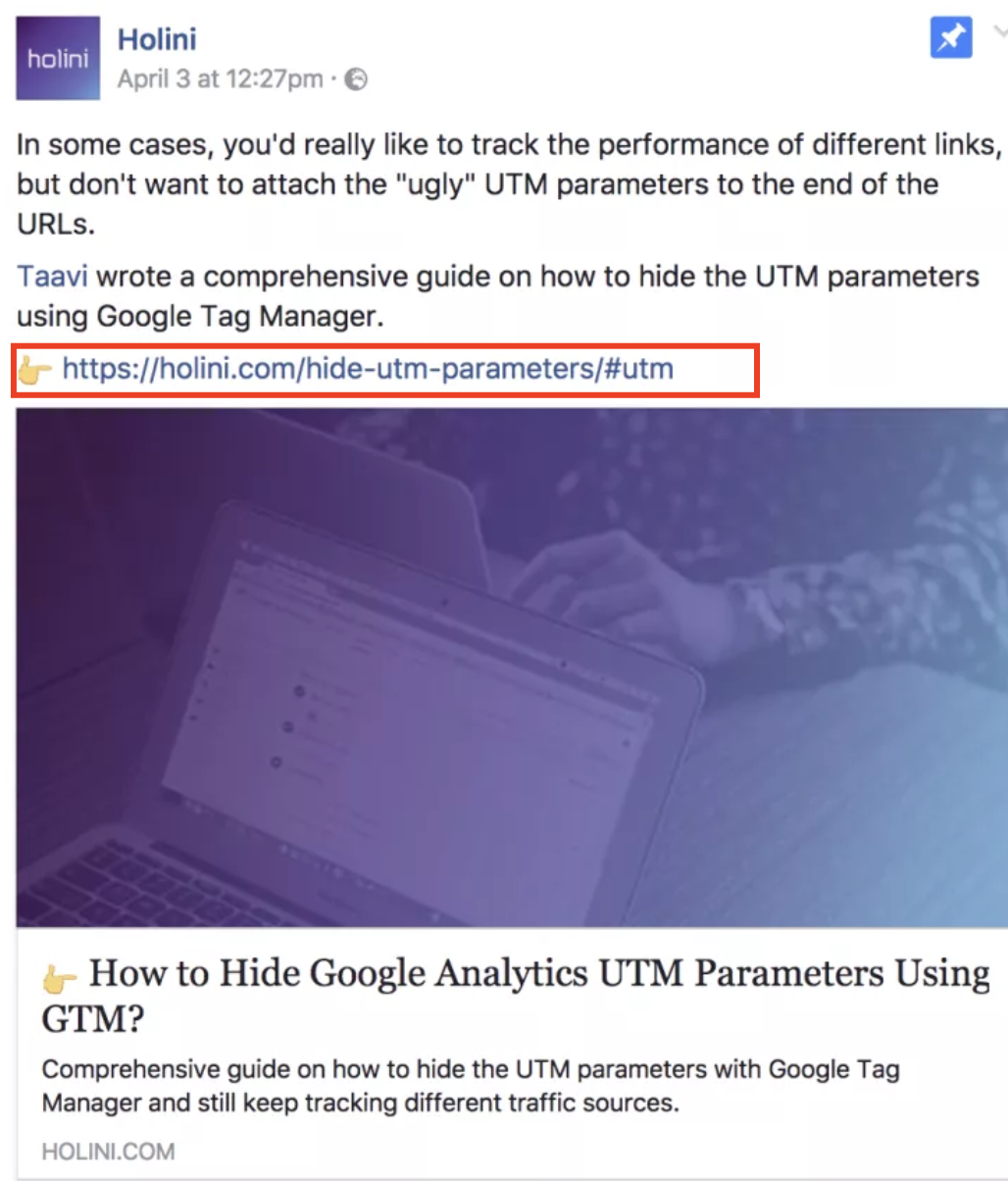
Include the URL in your ad copy as well
10. Create brightly colored ad creatives
Facebook and Instagram feeds are crowded with content, so we recommend that you test colorful ad images. (At least test them!)
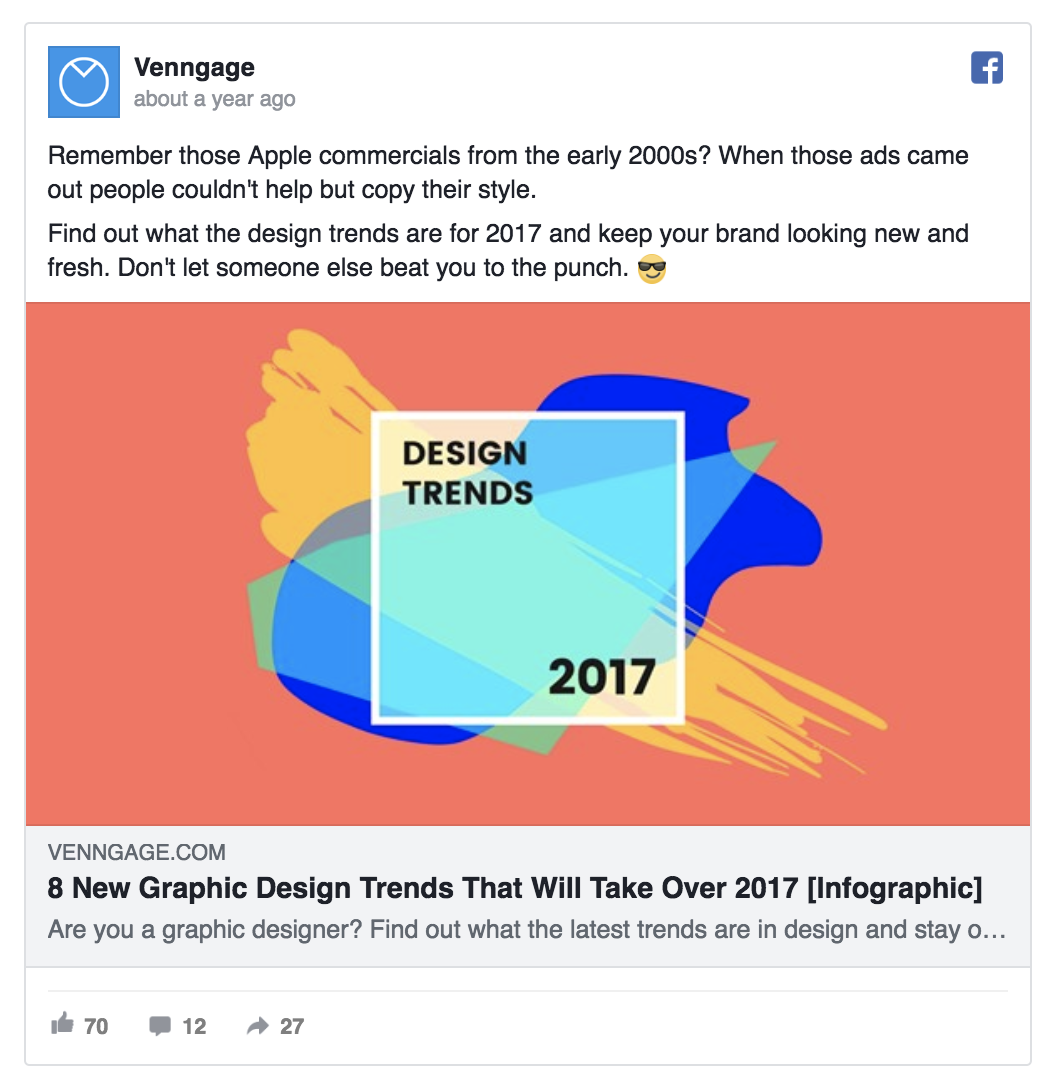
Colorful Facebook ad examples you can’t help but notice
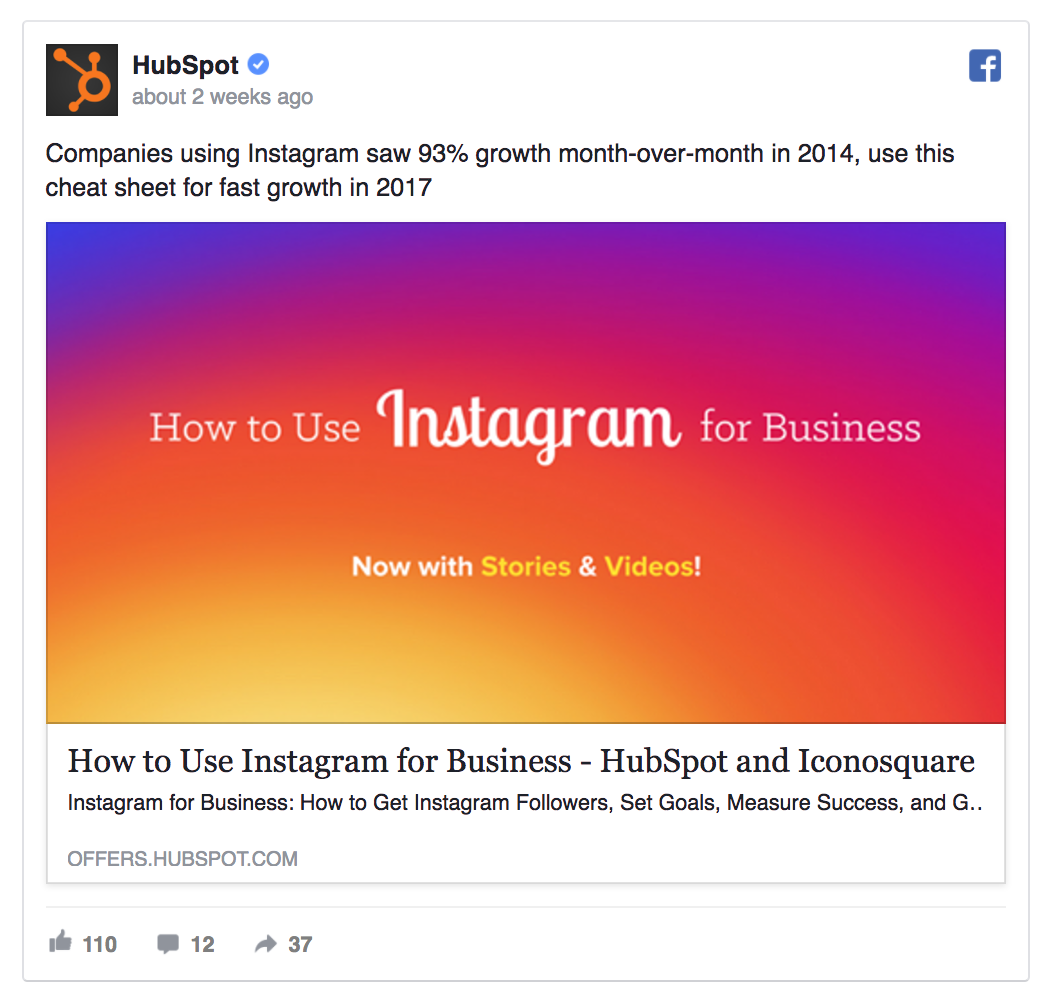
Colorful Facebook ad examples you can’t help but notice
11. Avoid using stock images and your ad creative
It would be so easy to simply download some free stock images and use these as your Facebook ad creatives.
However, that’s what other advertisers think as well. The result is millions of people using the same picture across their marketing channels, reducing the chances of your Facebook ads being noticed significantly.
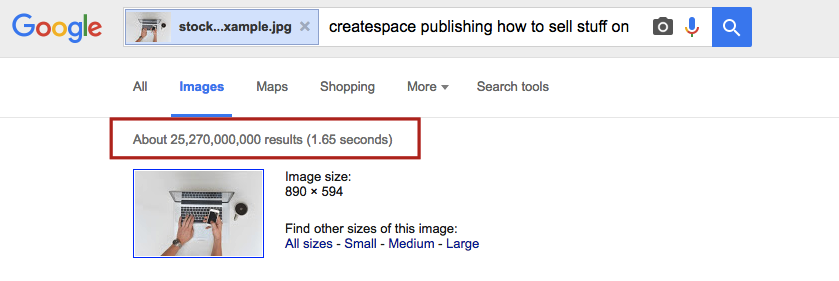
This free stock image has been used 25,270,000,000 times
If you do not have an in-house designer, use tools like Canva to create ad visuals or hire a freelancer through UpWork or Fiverr.
13. Create ads that are out of the box
Facebook’s wide variety of ad types calls for some creative experimentation.
For example, you can use the Carousel ad format to create visuals that run through multiple carousel slides.
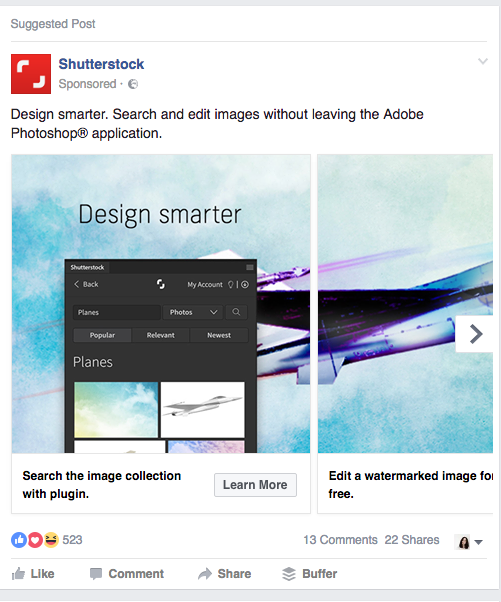
Shutterstock Creative Carousel Ad #1
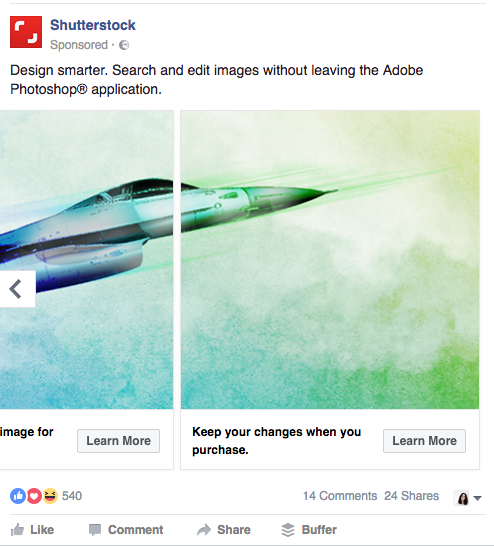
Shutterstock Creative Carousel Ad #2
Shutterstock’s ad uses Facebook Carousel ad format in a creative way
13. Ask your team and friends to like your ads and posts
Every time you publish a new Facebook post, ask your team to go and like it, even better if they will also share. This will help your post get the first critical likes under it and also indicated to a higher engagement rate to Facebook’s algorithms, which in turn can help to lower the CPC.
14. Make sure to reply to all the Facebook comments
If you’re promoting your Facebook posts or running ad campaigns, at one point or another you will get some comments under your ads. Make sure to engage with your audience in the comments section. And yes, even negative comments require a reply.
Here’s a nice example by Airbnb. They sometimes get more than a thousand comments per post, but still manage to keep a lighthearted tone of voice when giving a reply.
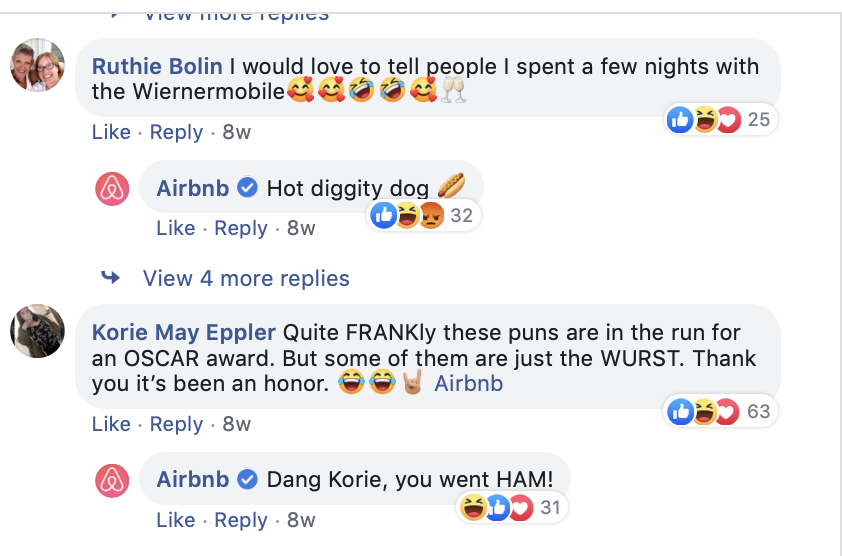
Airbnb engages with their facebook posts’ commentators
15. Test advertising to various audiences
One of the biggest difference-makers in Facebook advertising is your target audience. Test setting up ad campaigns for various audience segments to see which one converts the best.
Here are some ideas to get you started:
- All your past 30 or 60 days website visitors (Custom Audience)
- All your Pricing landing page visitors (Custom Audience)
- Specific landing page visitors (Custom Audience)
- Email list subscribers (Custom Audience)
- Blog readers and the readers of particular articles(Custom Audience)
- Free trial and freemium users (Custom Audience)
- People similar to your existing customer base (Lookalike Audience)
- People interested in your competitors’ brands (Saved Audience)
- A wide audience of people interested in your industry (Saved Audience)
You’ve reached the end of the article, which is the right time to say “Congrats” for mastering a list of Facebook PPC strategies! 🙌
If you’d like to learn more about Facebook advertising, check out these guides:
B2B Facebook Ads – The Complete Guide to Grow Sales in 2019
Facebook Ad Targeting in 2019 – Reach the Right Audience for Higher ROI
Karola Karlson
Content Writer
Karola is all about random cool ideas, growth marketing, and taking new marketing approaches on a test drive. And boy does she love conversion copywriting or any writing for that matter (ask anyone who’s worked with her). Want to collaborate with Karola? Send her some delicious black chai, and then we’re talking!
Leave us a comment.
Subscribe to our blog
Subscribe to our blog
Get weekly PPC & CRO advice sent straight to your inbox.